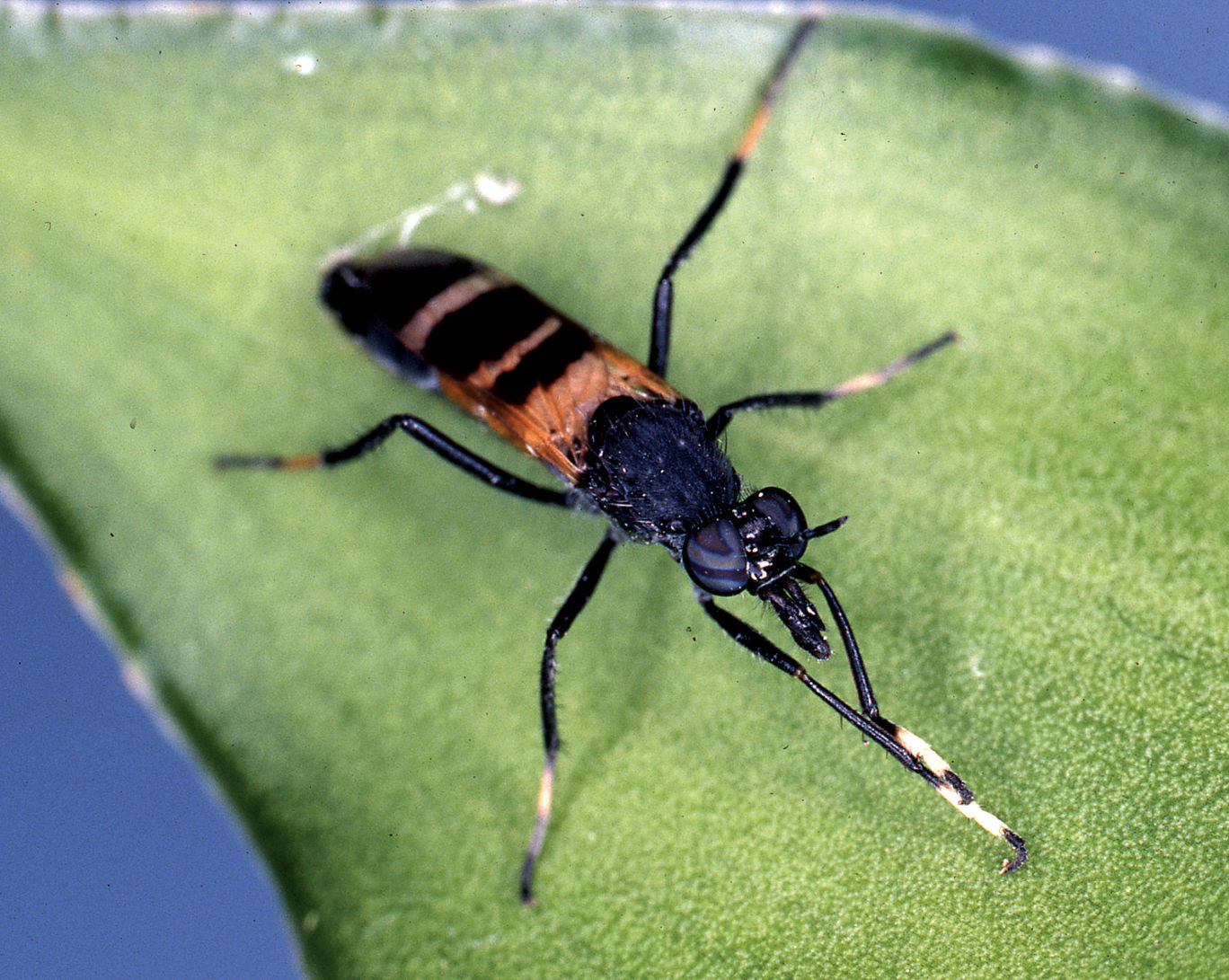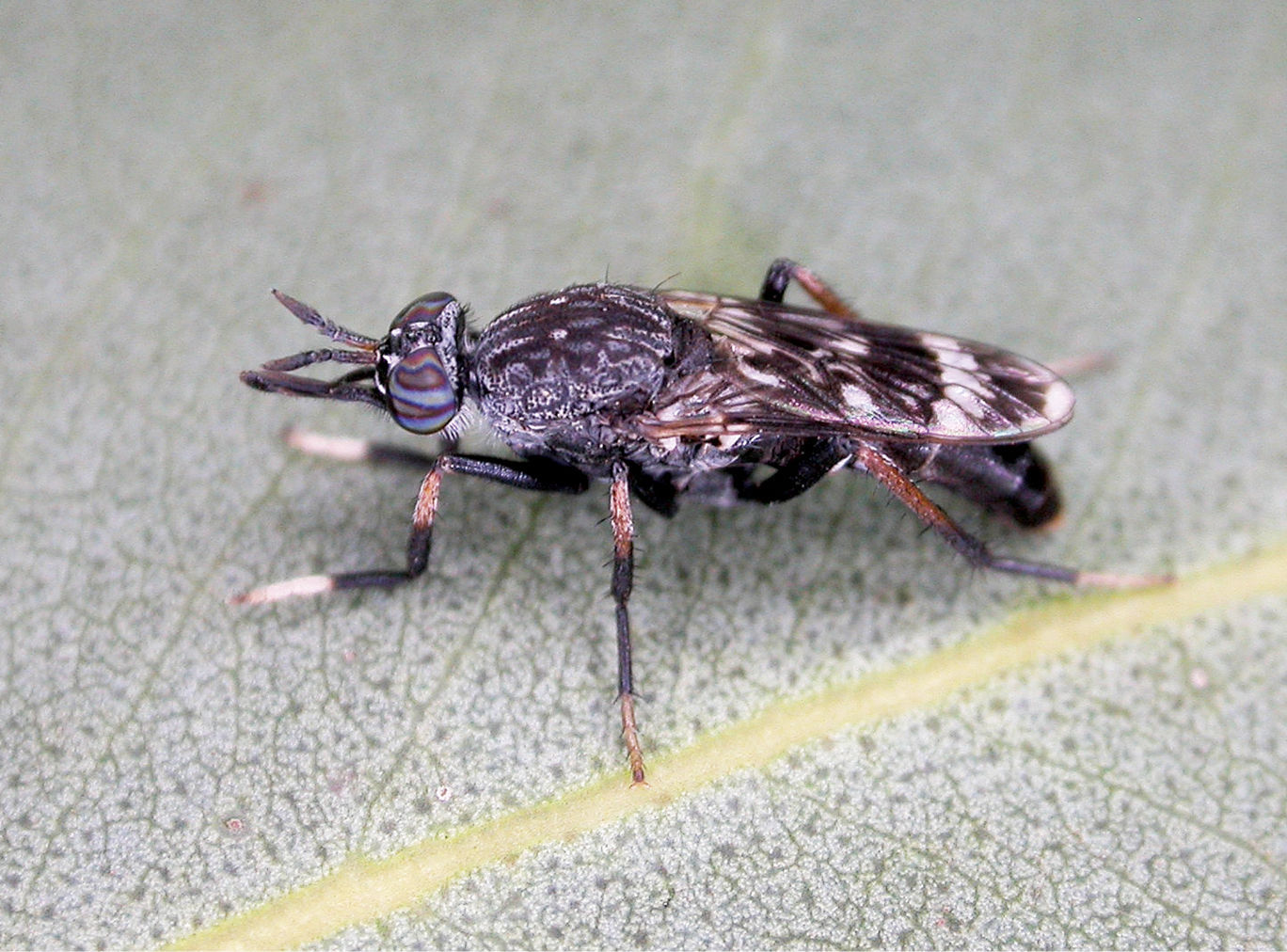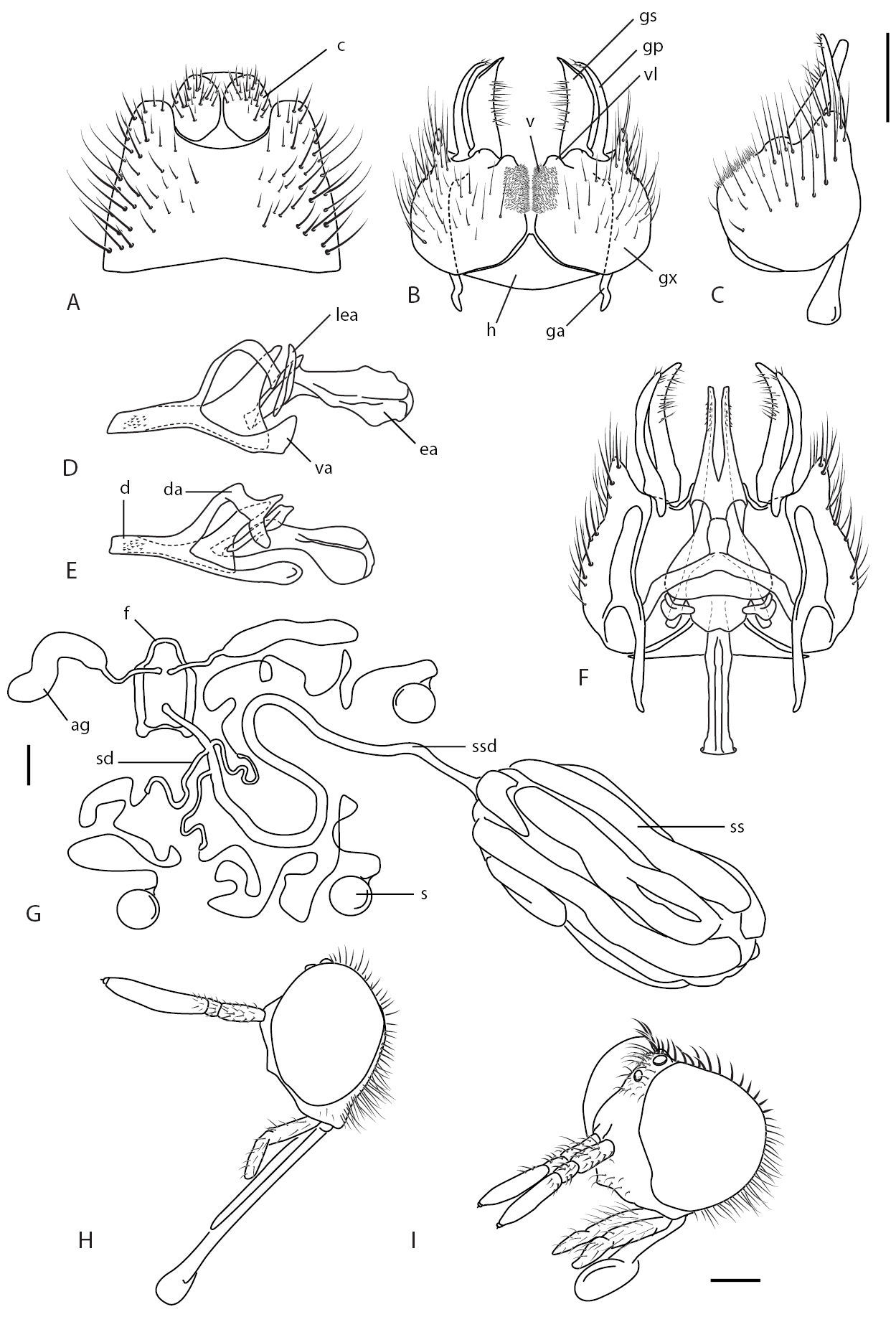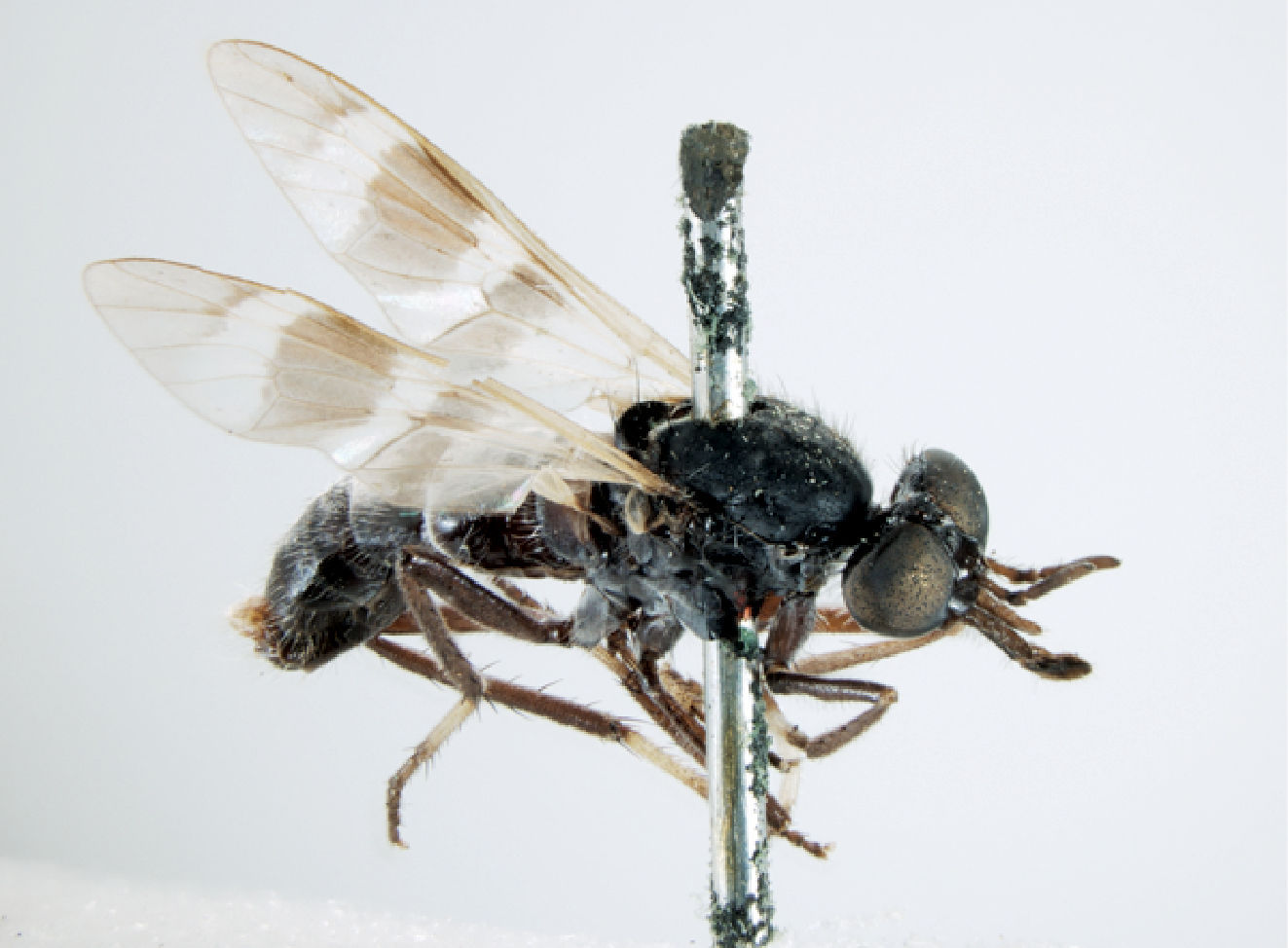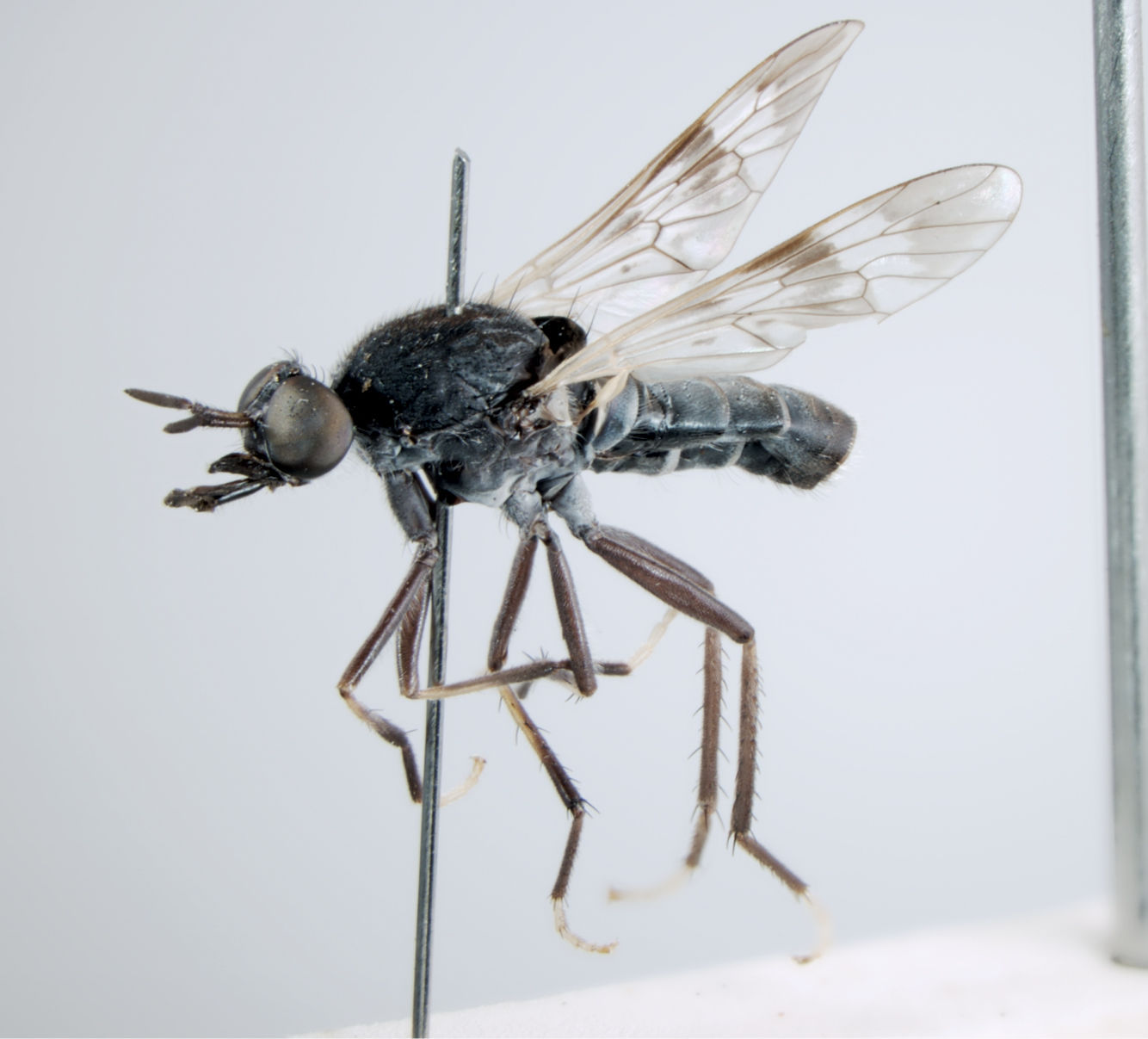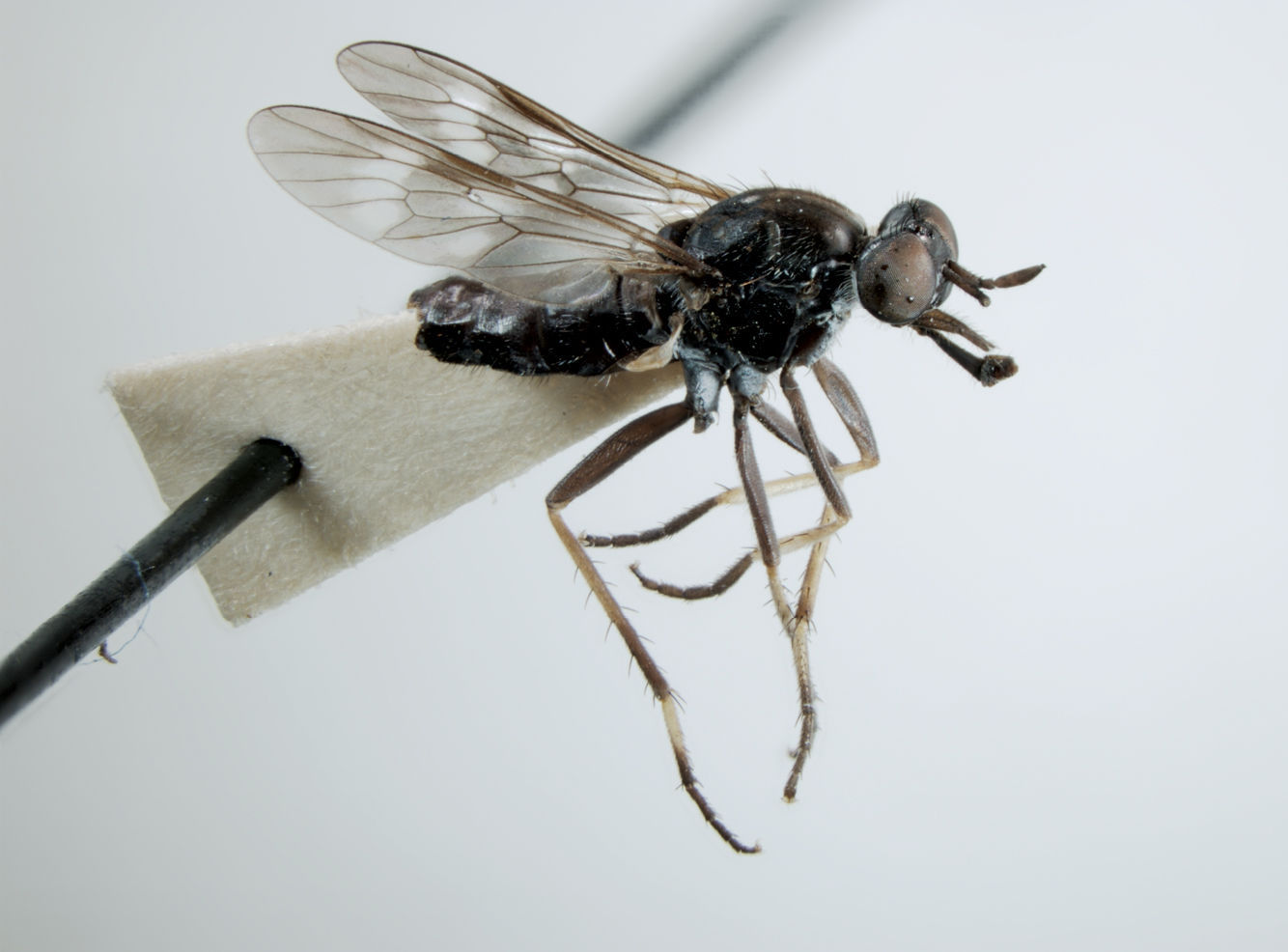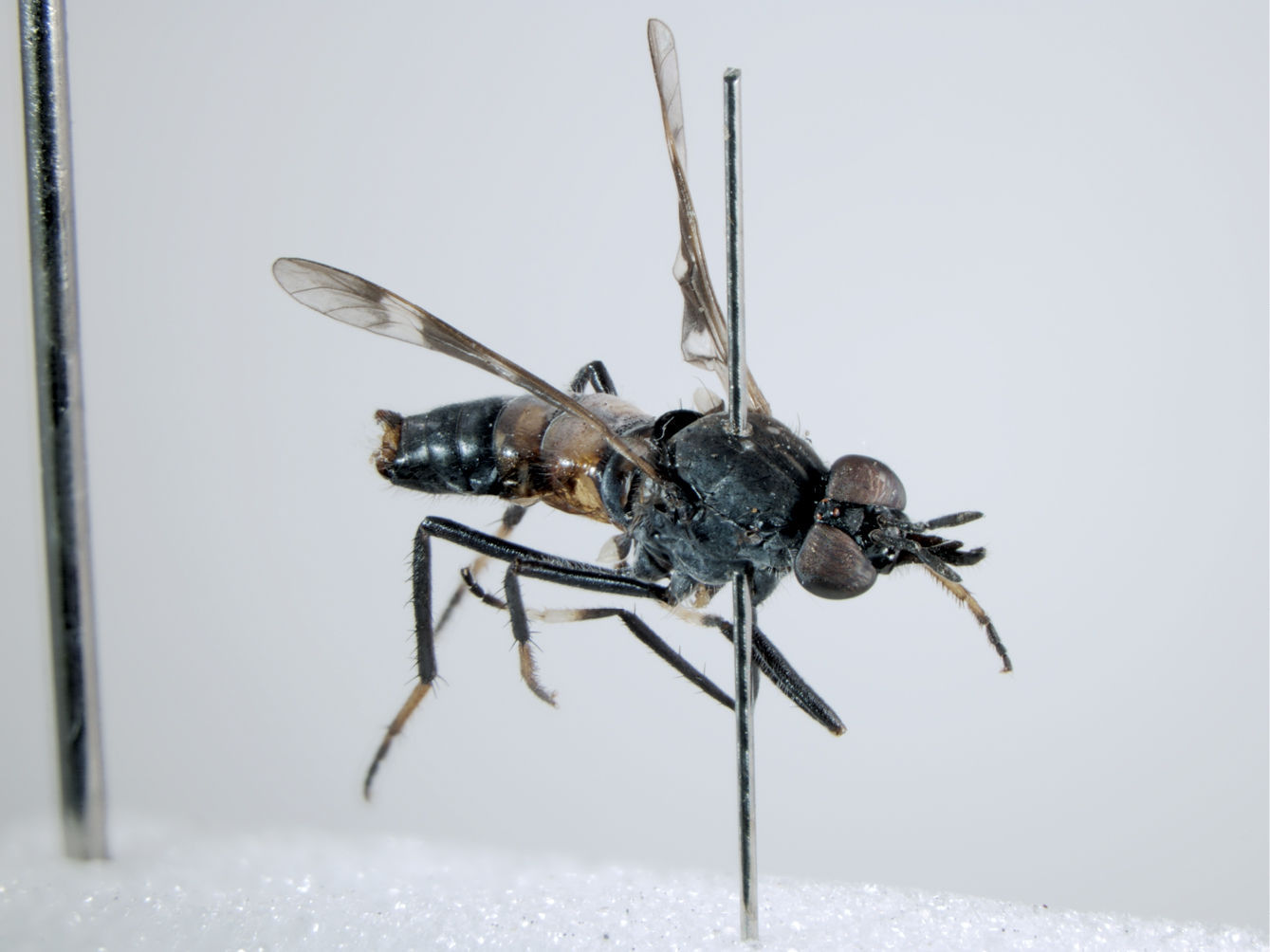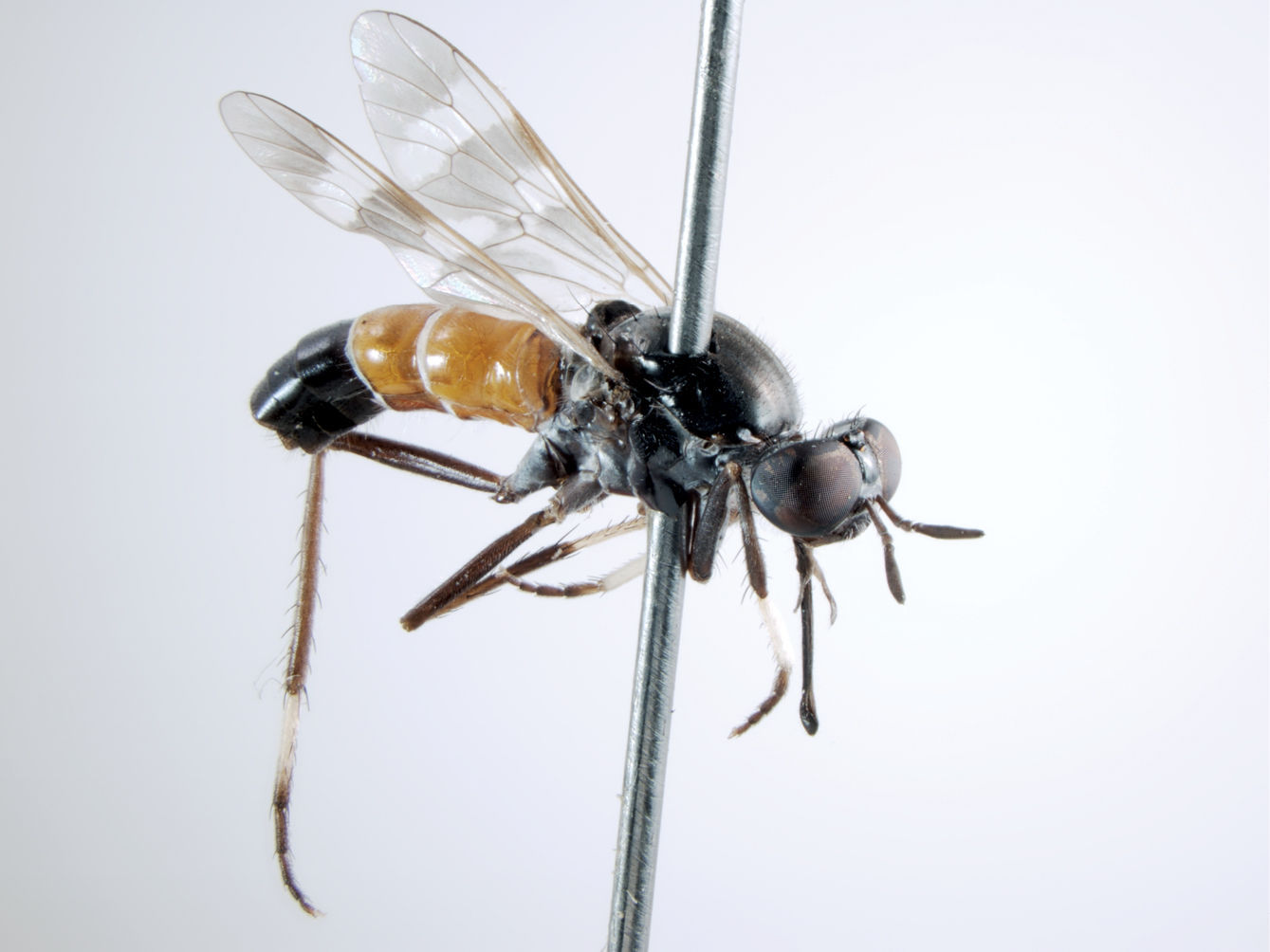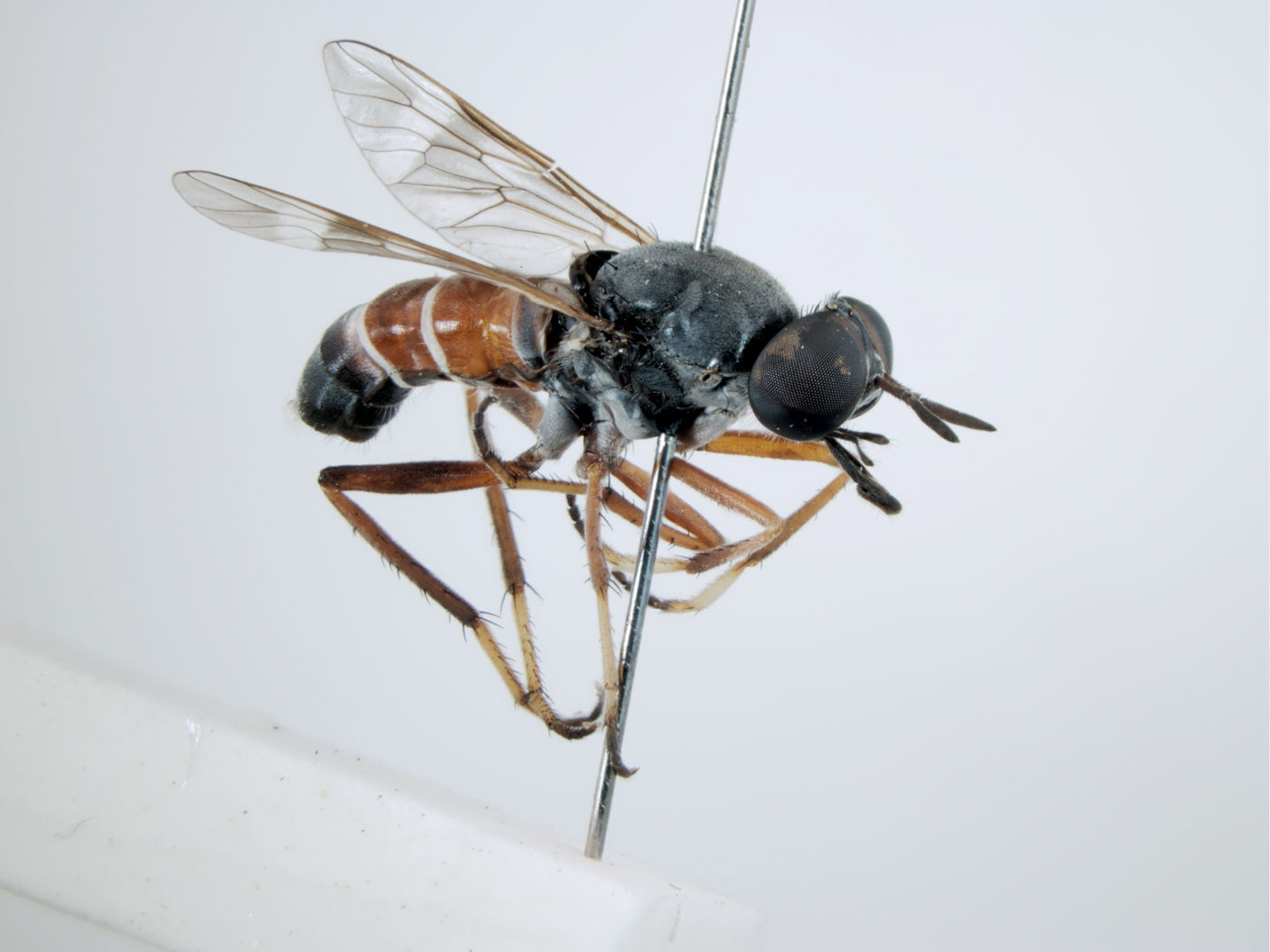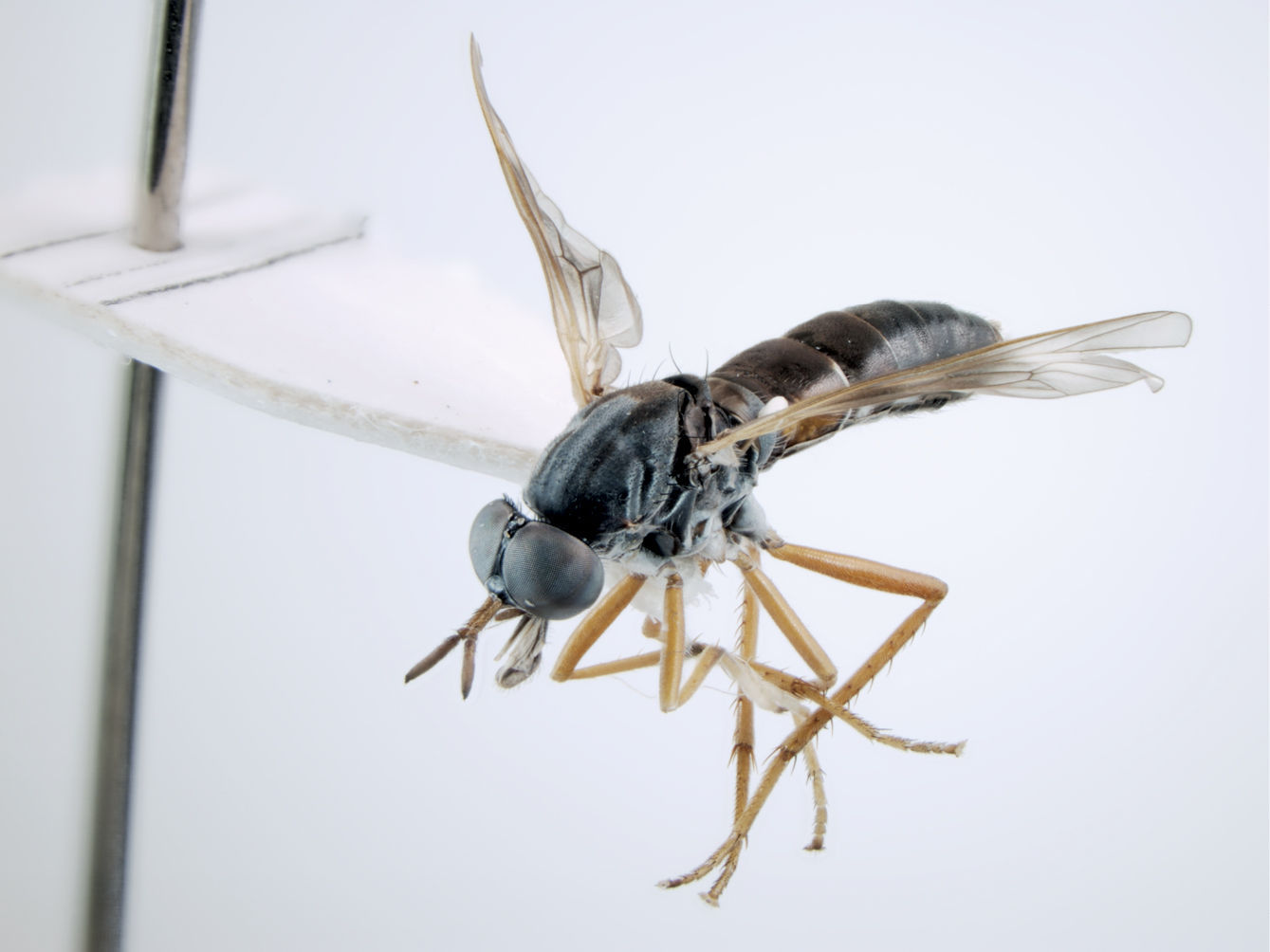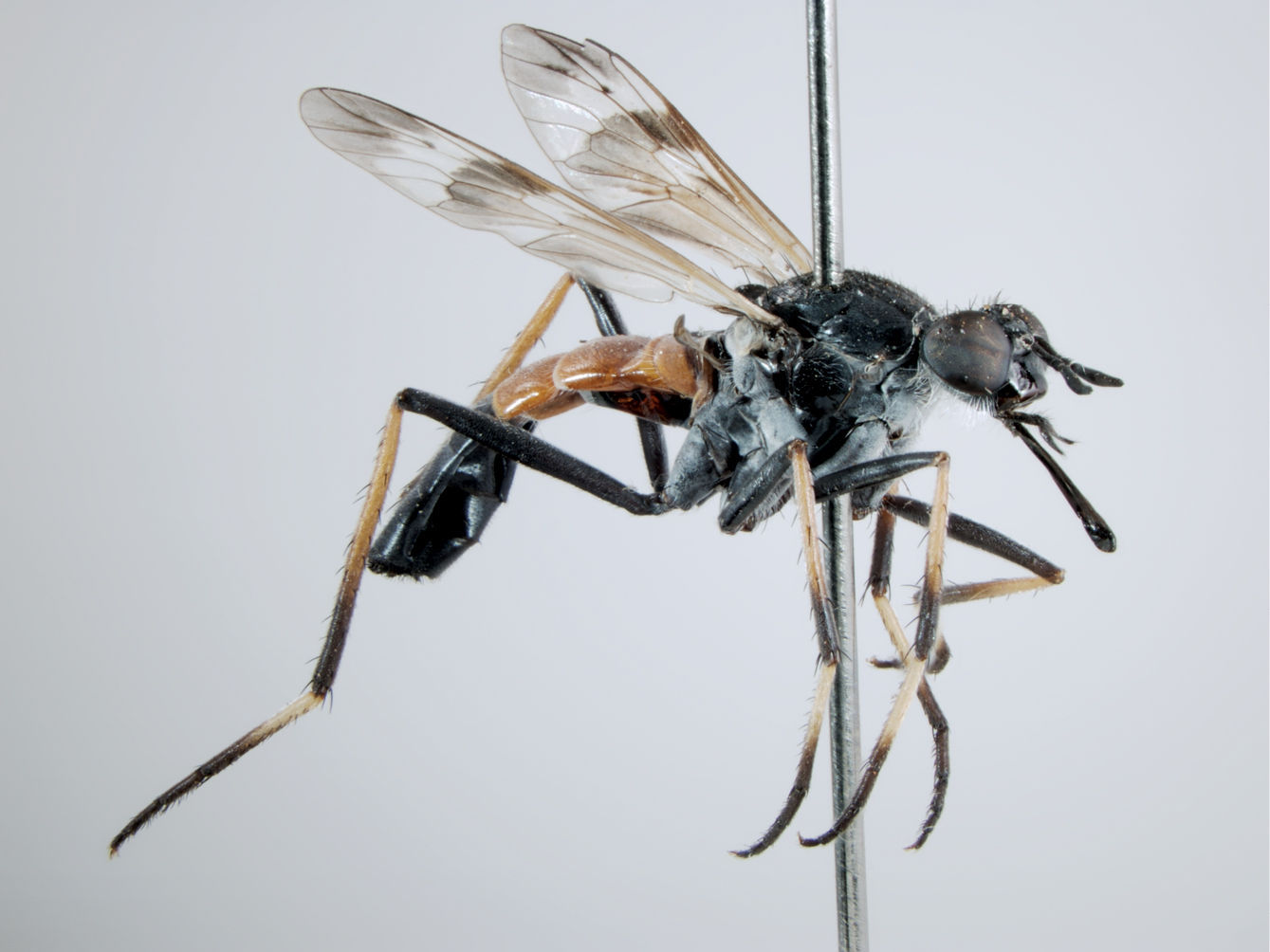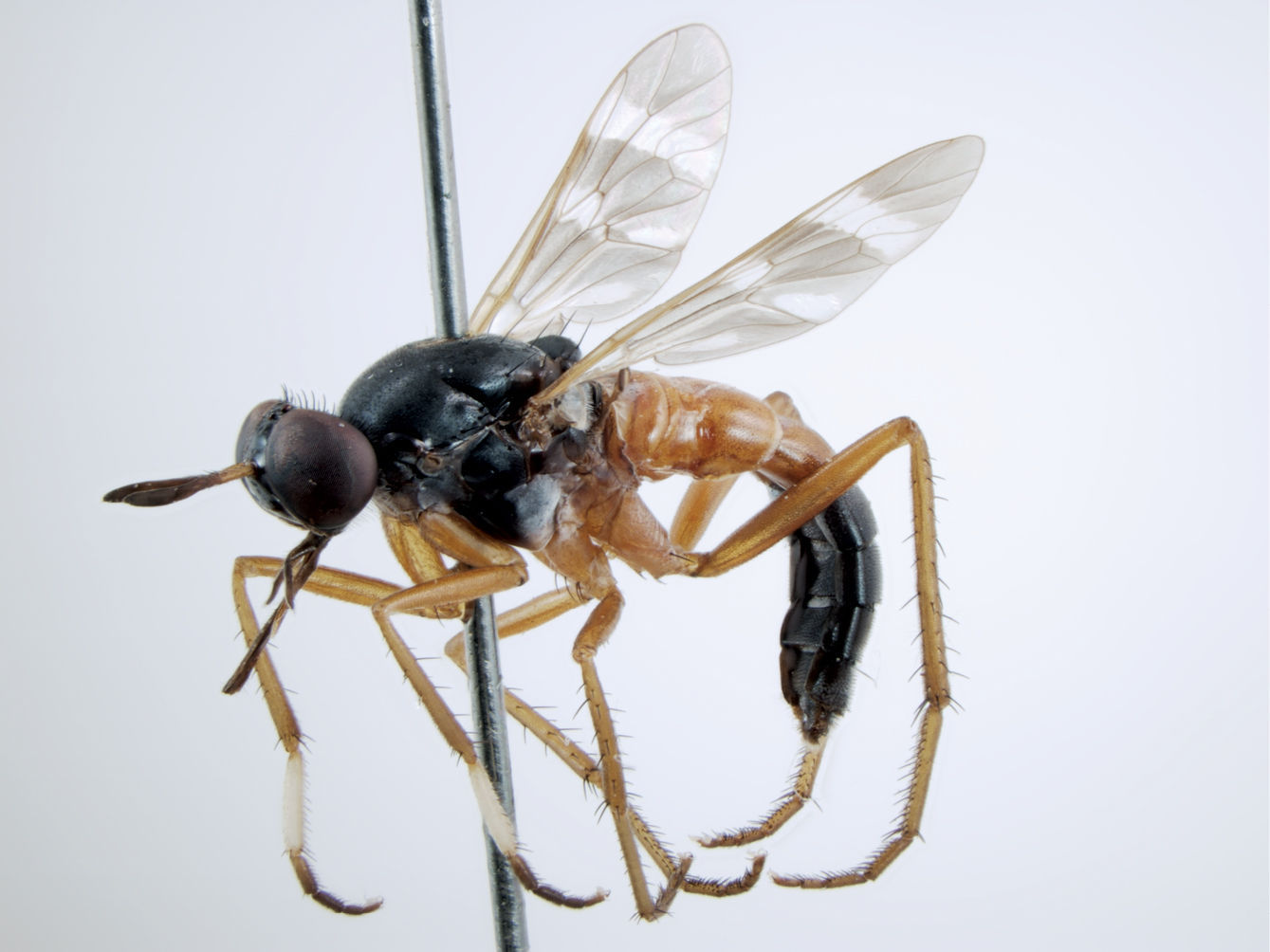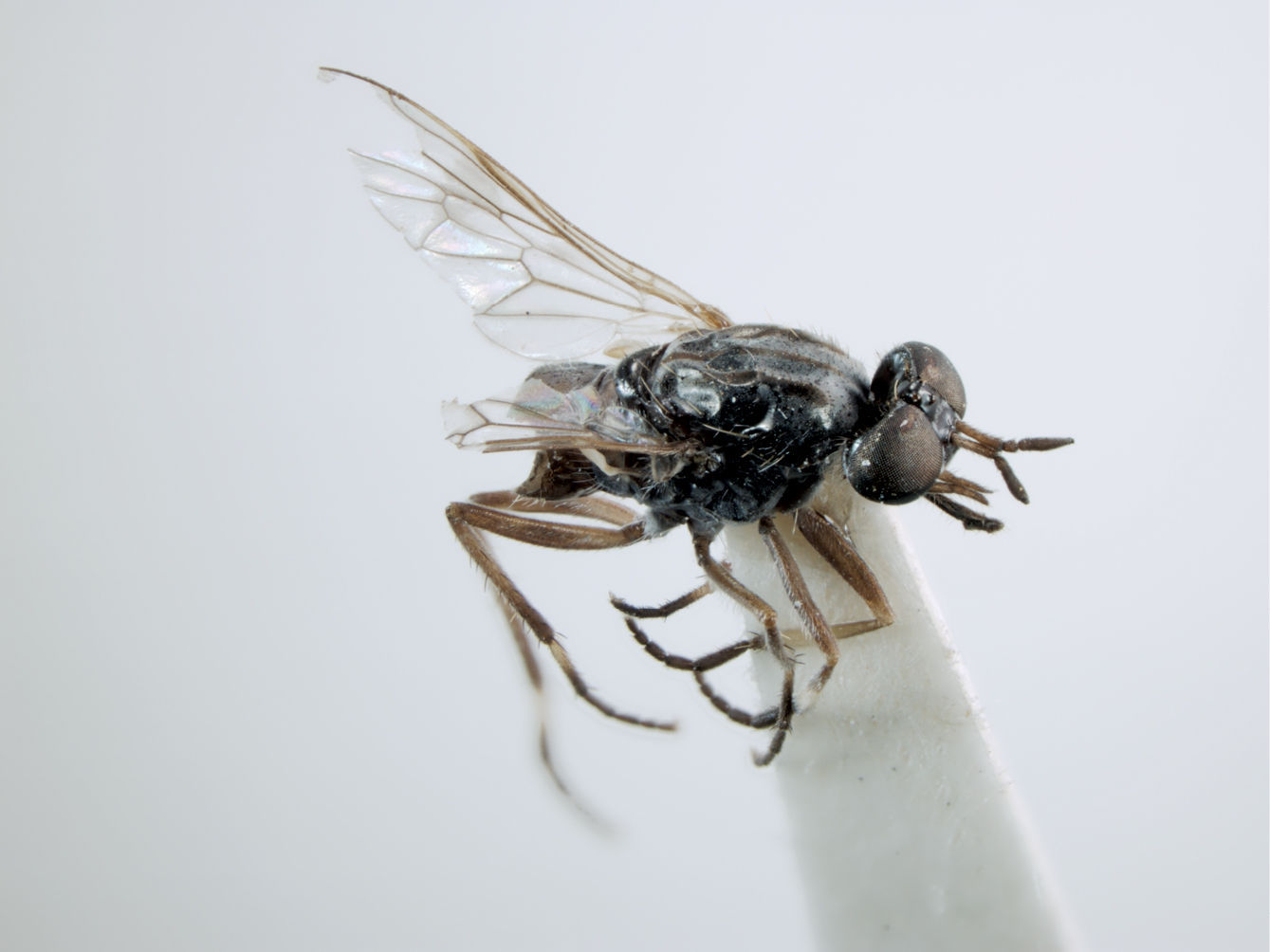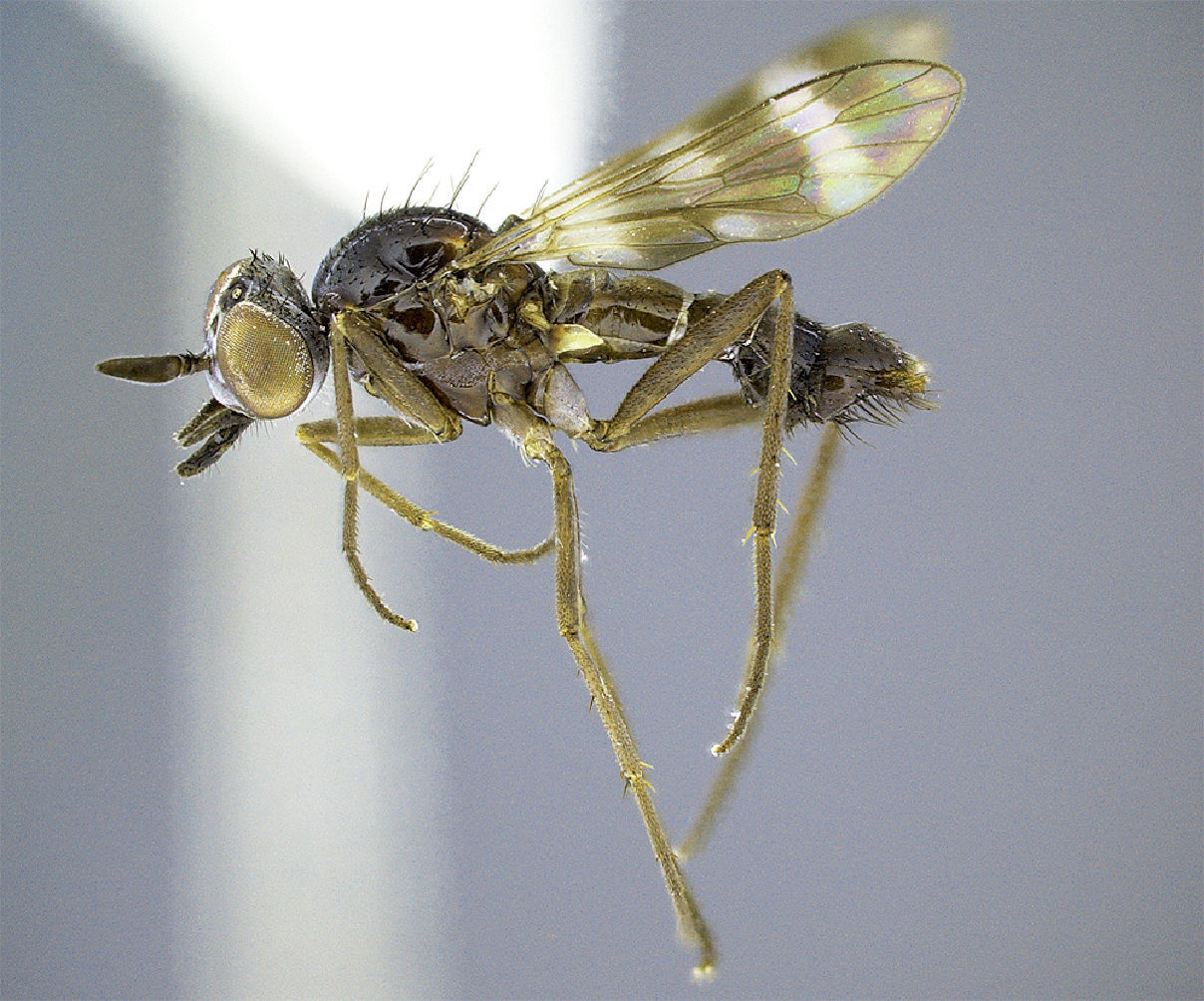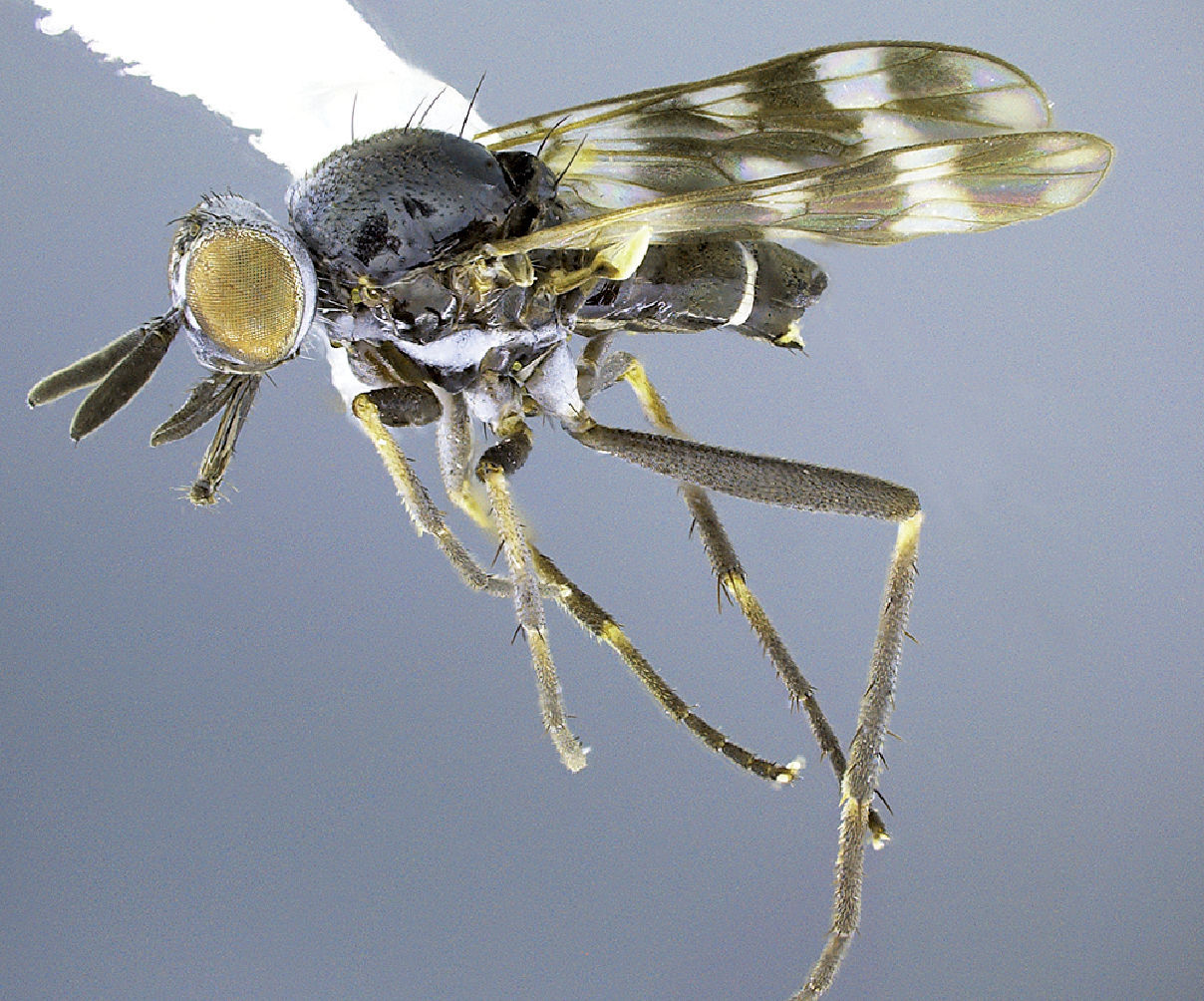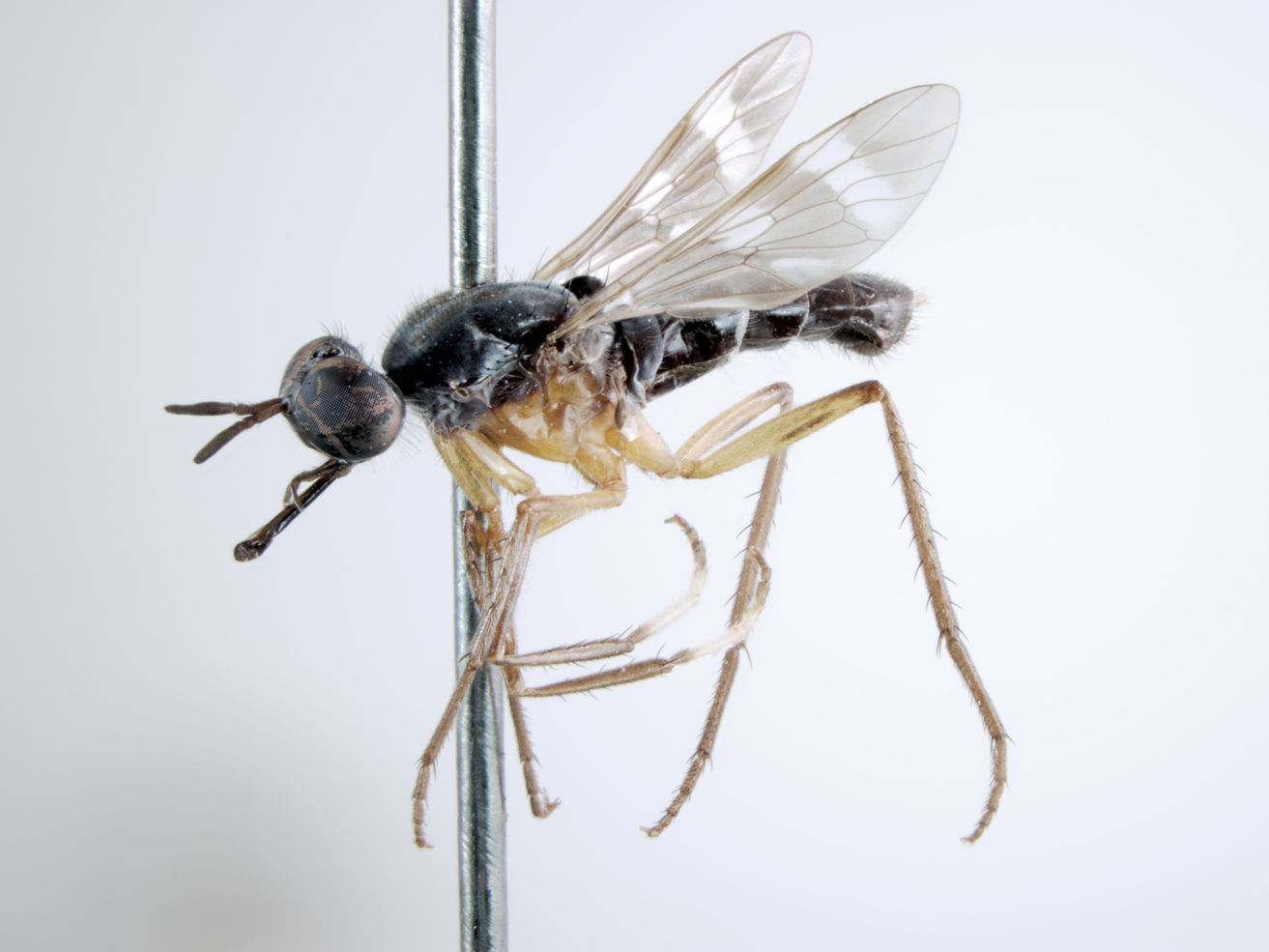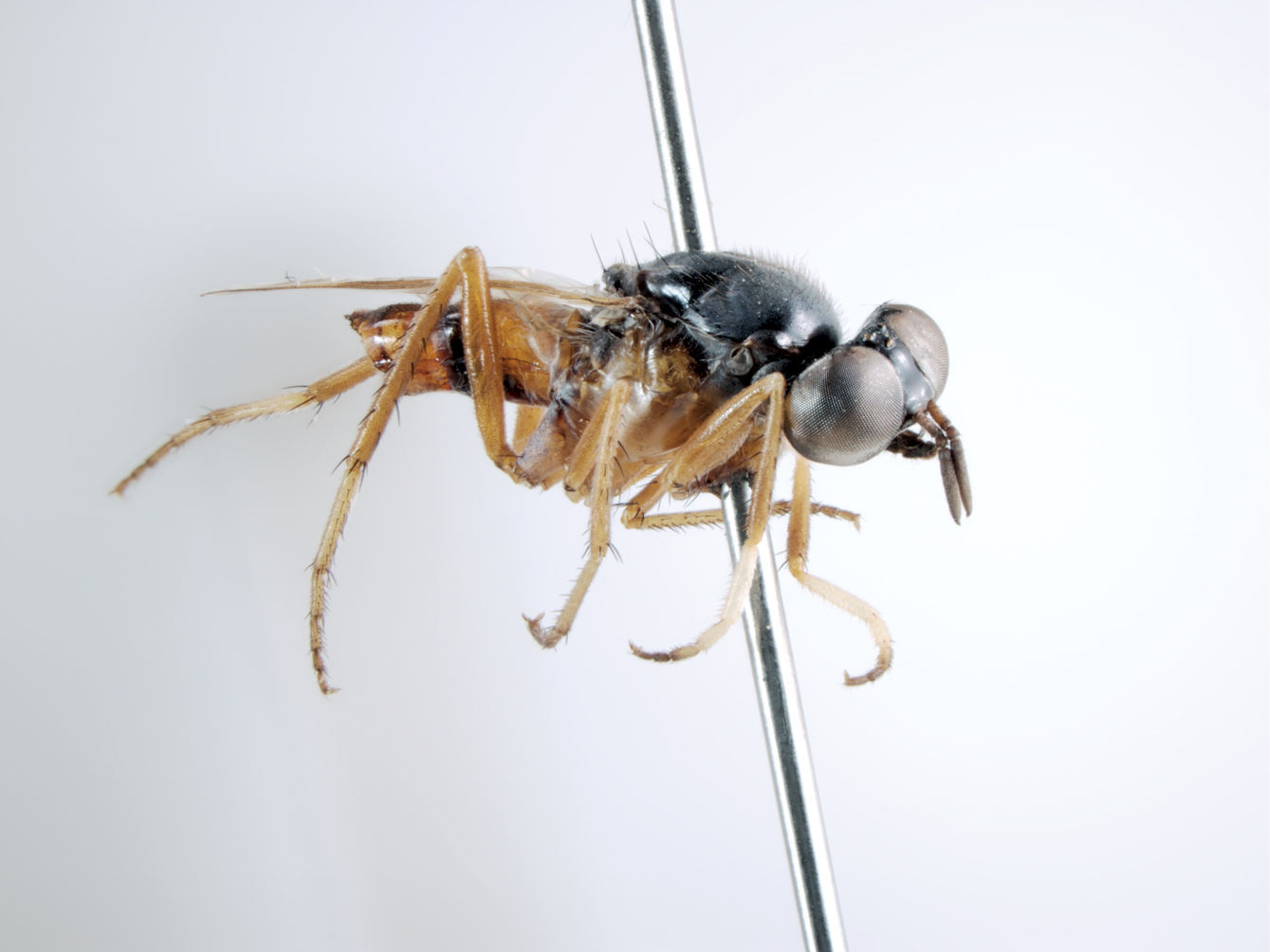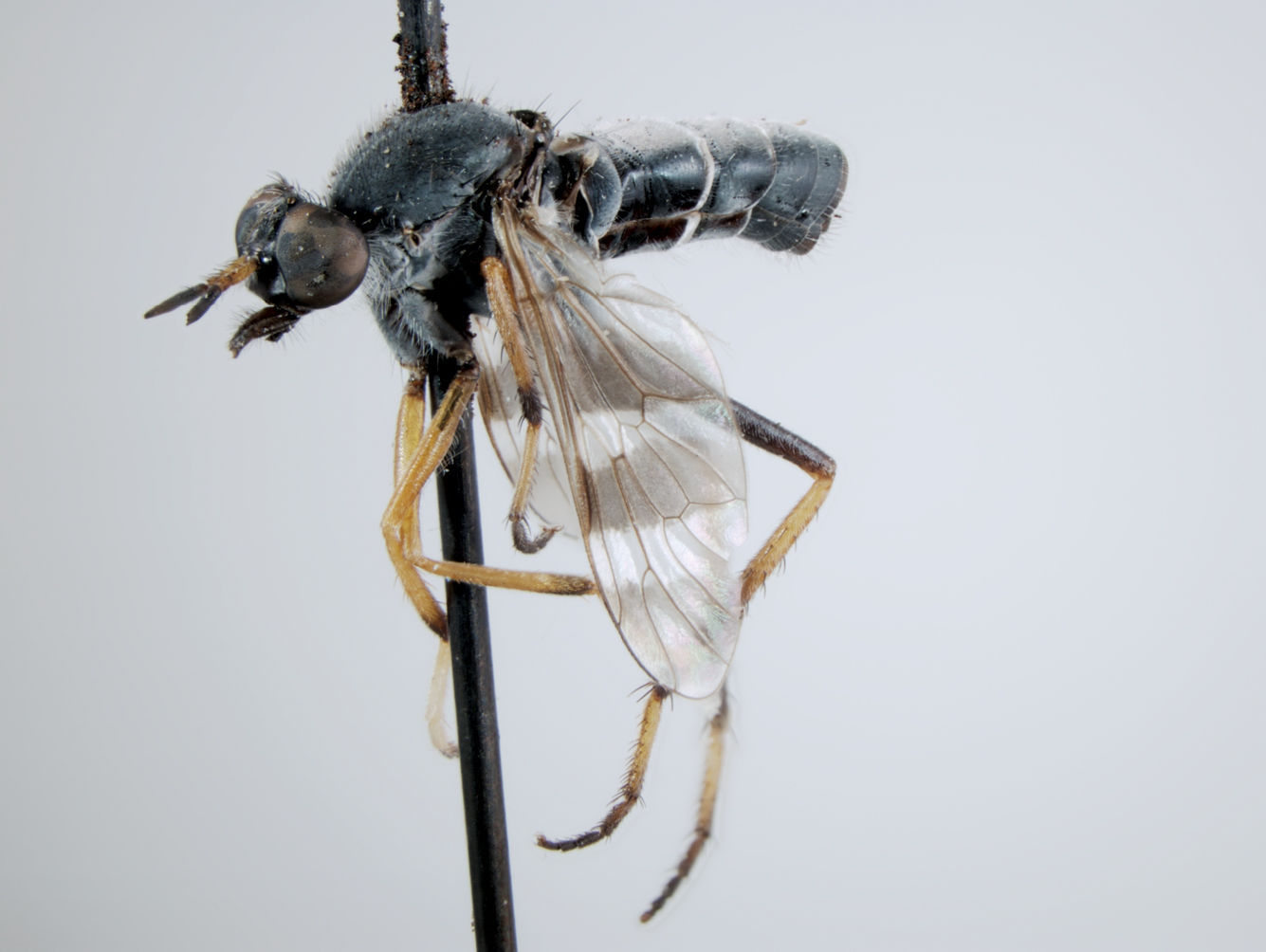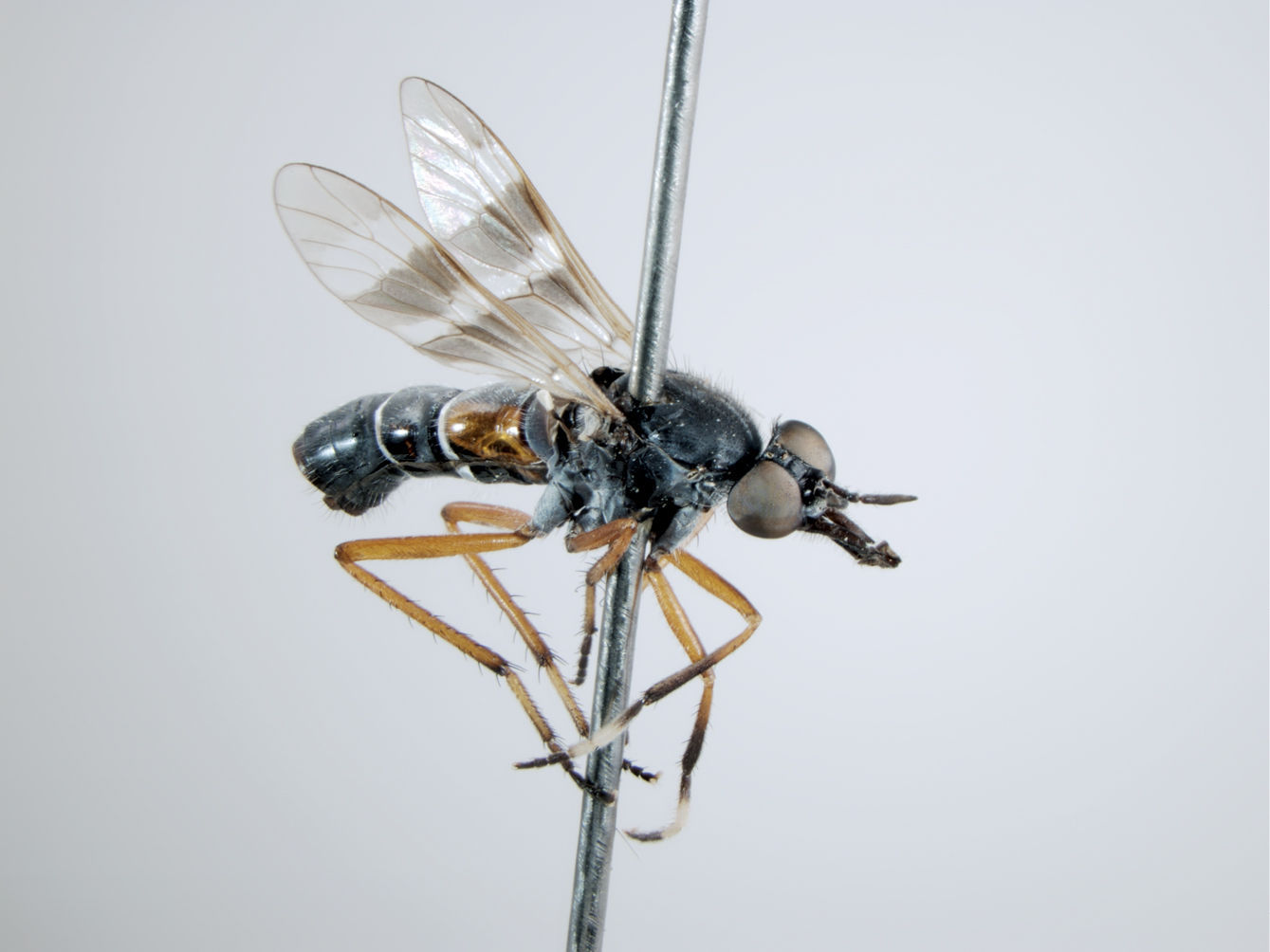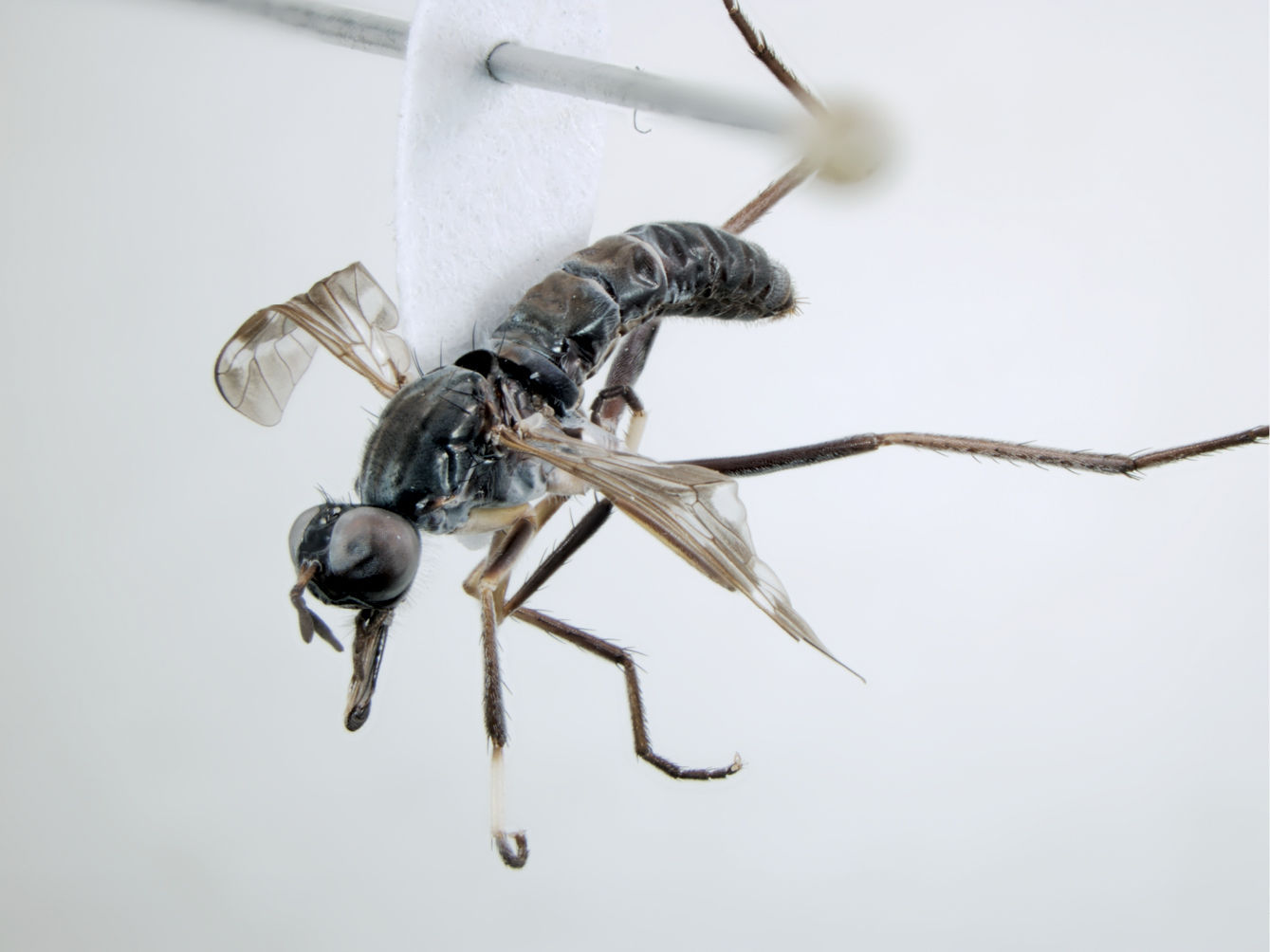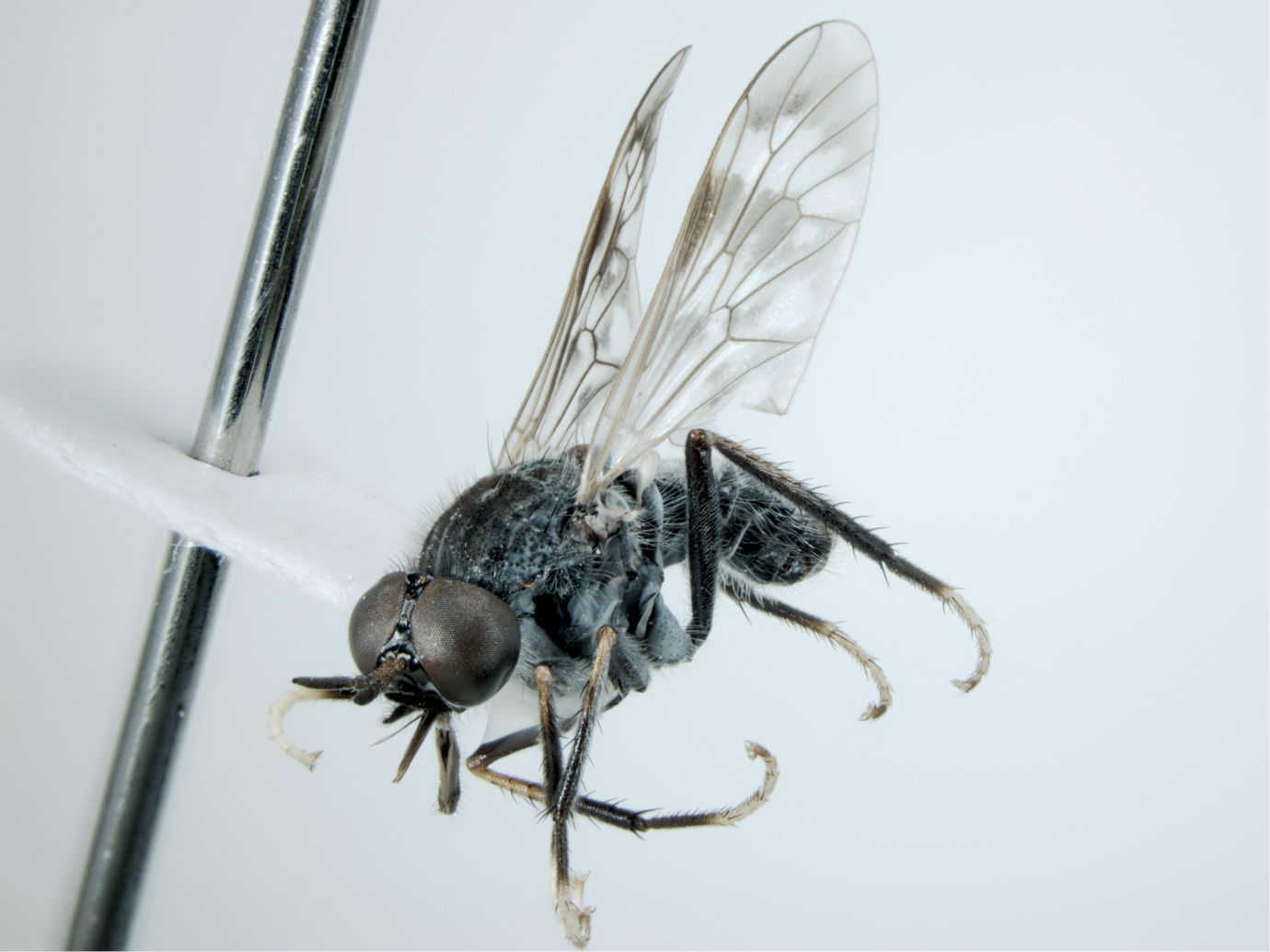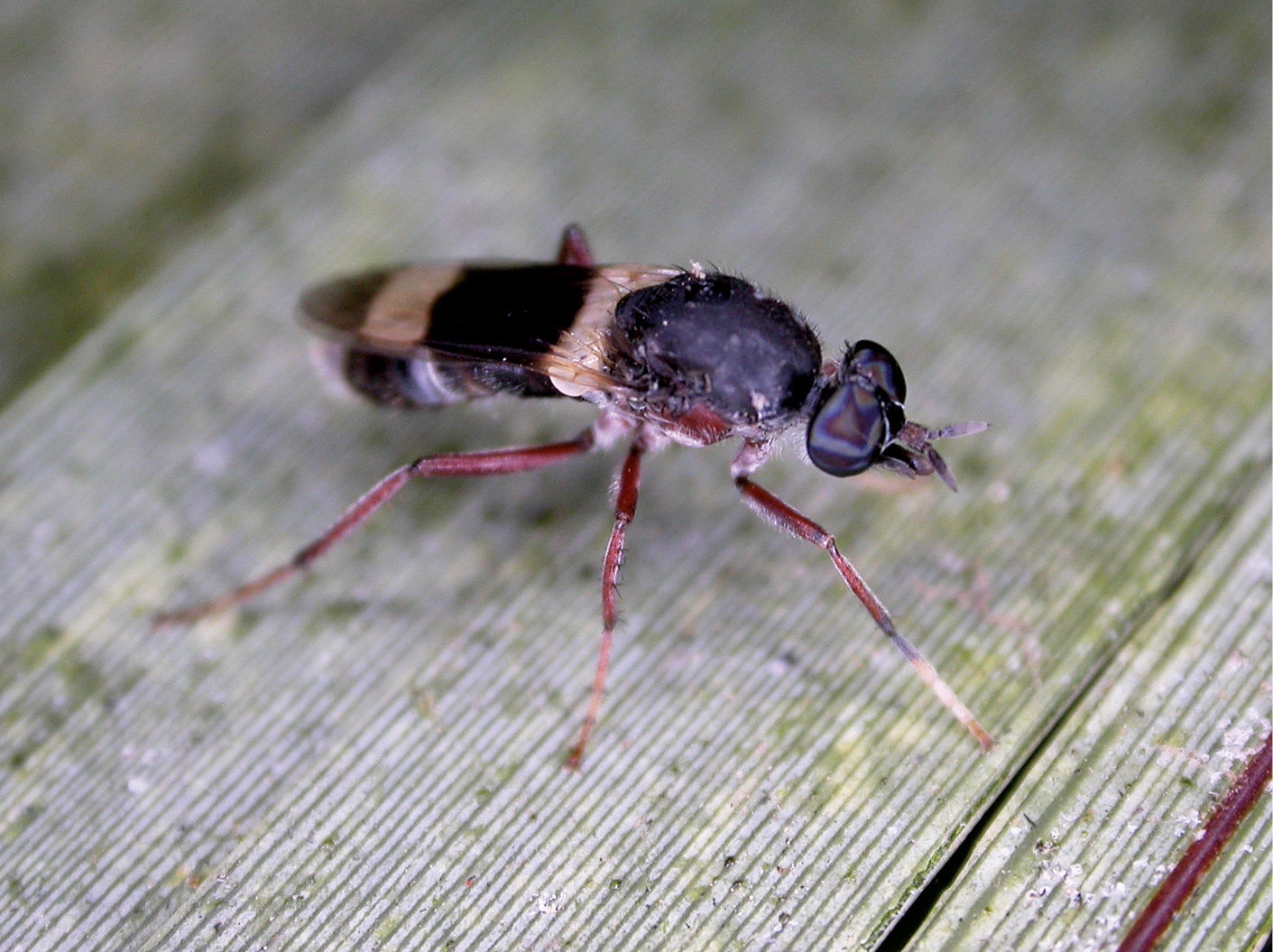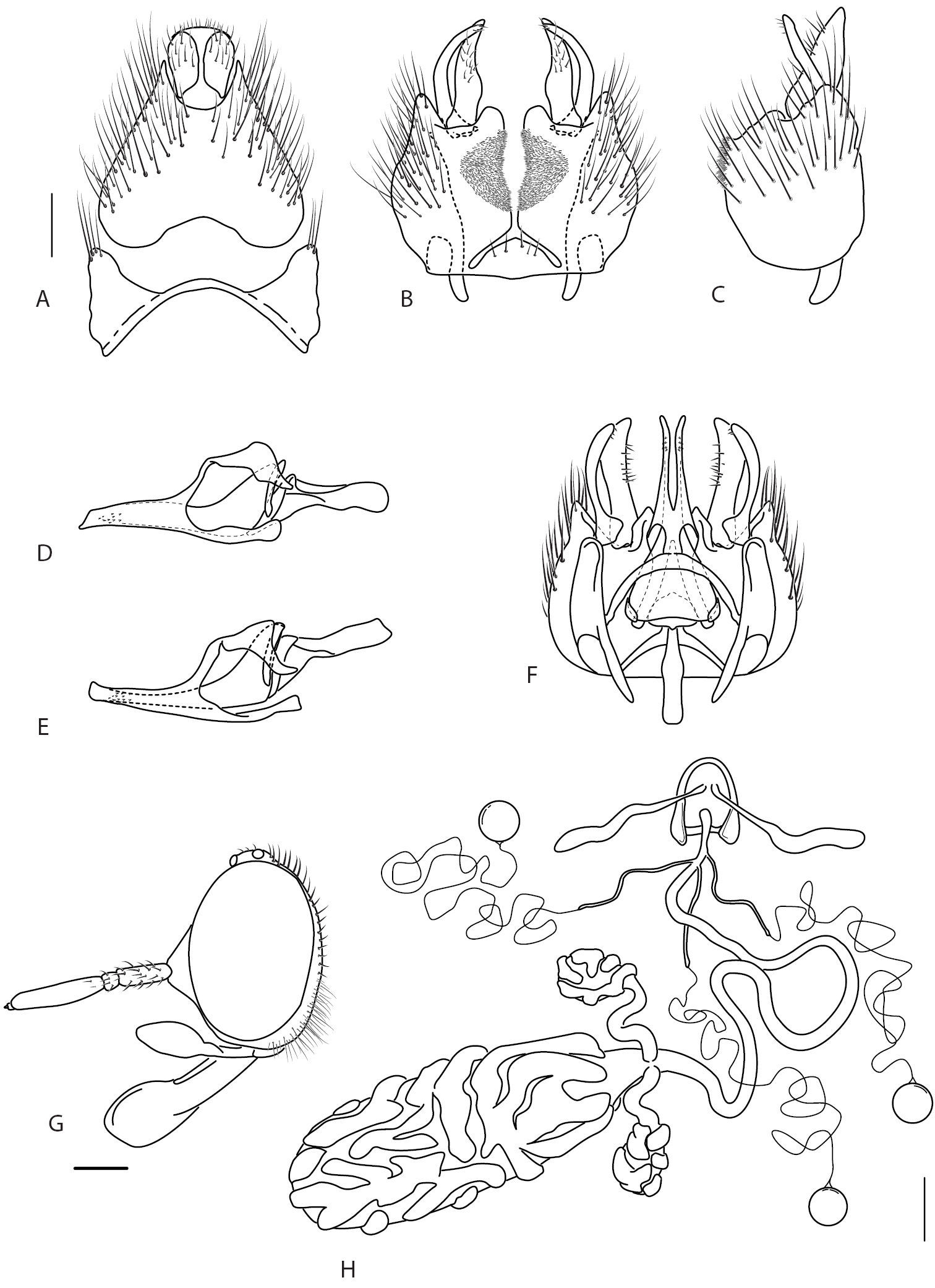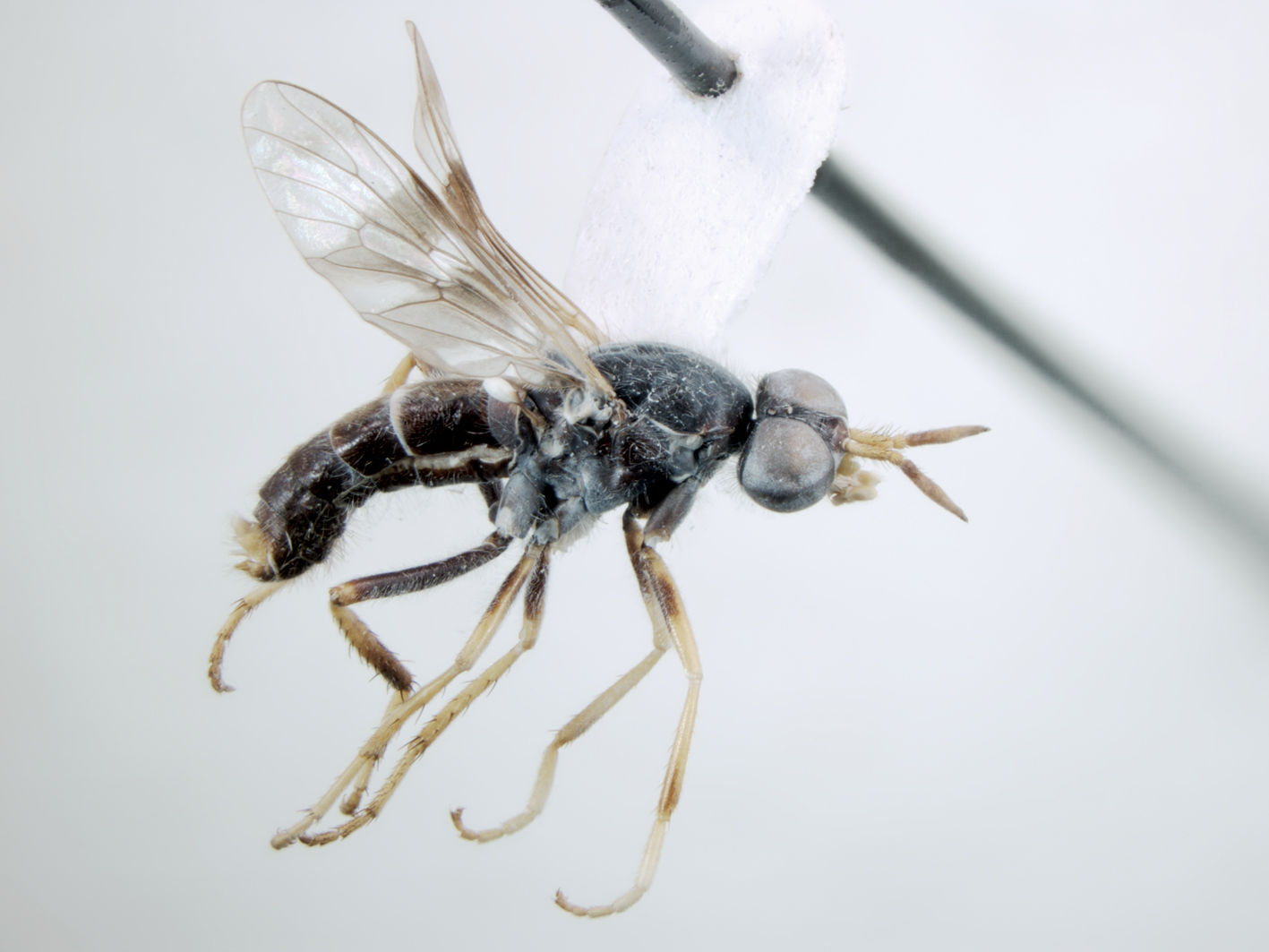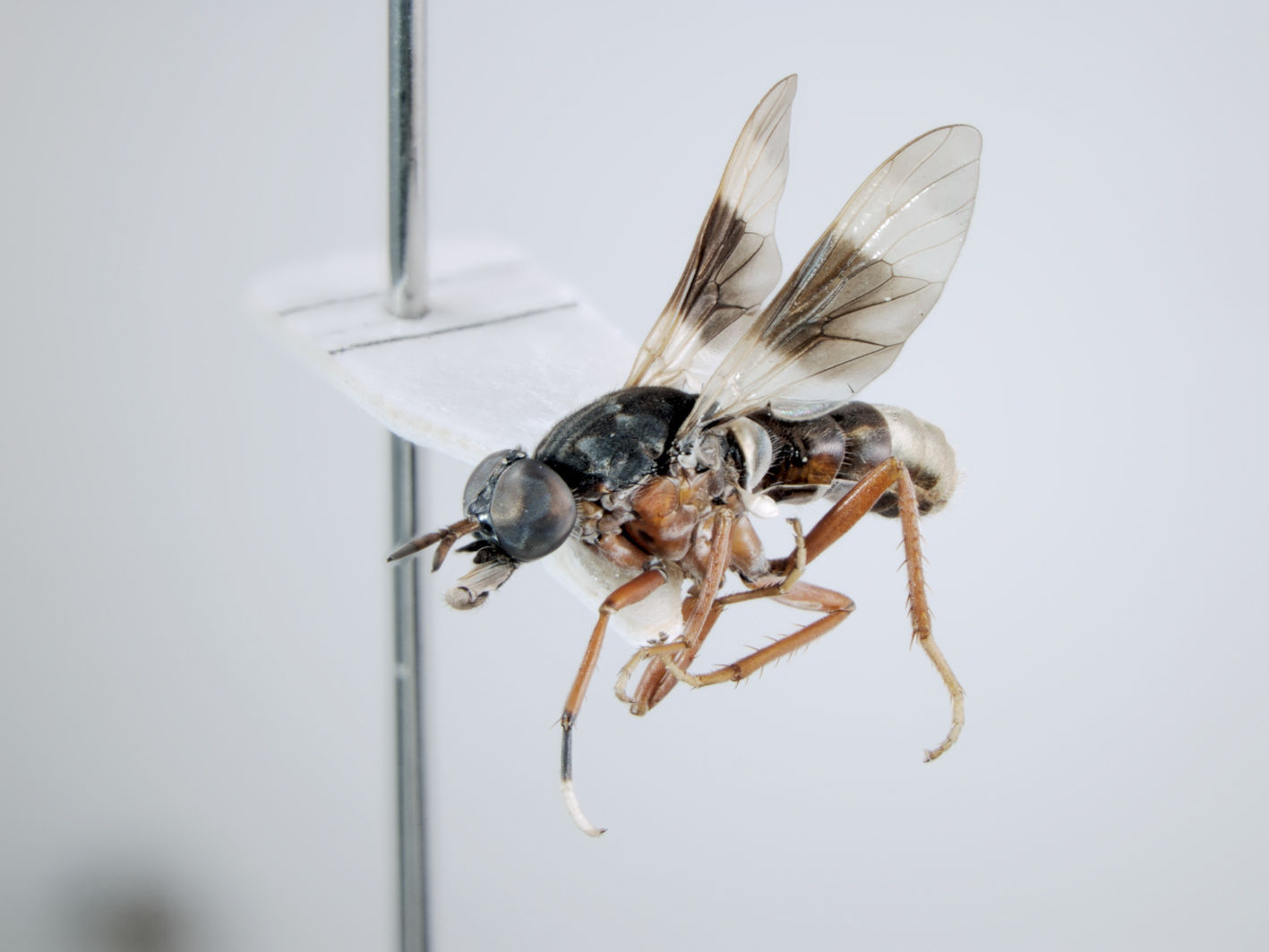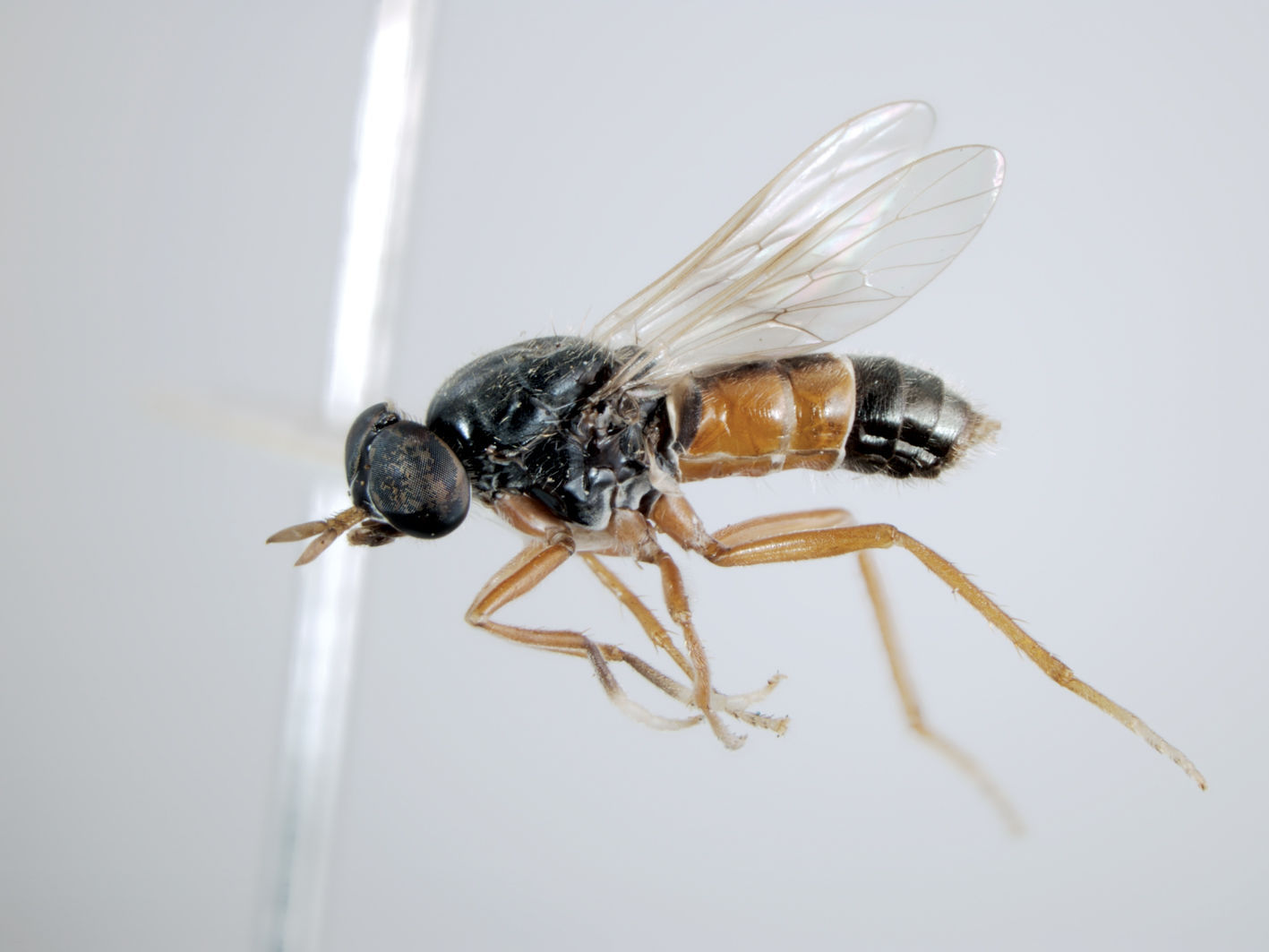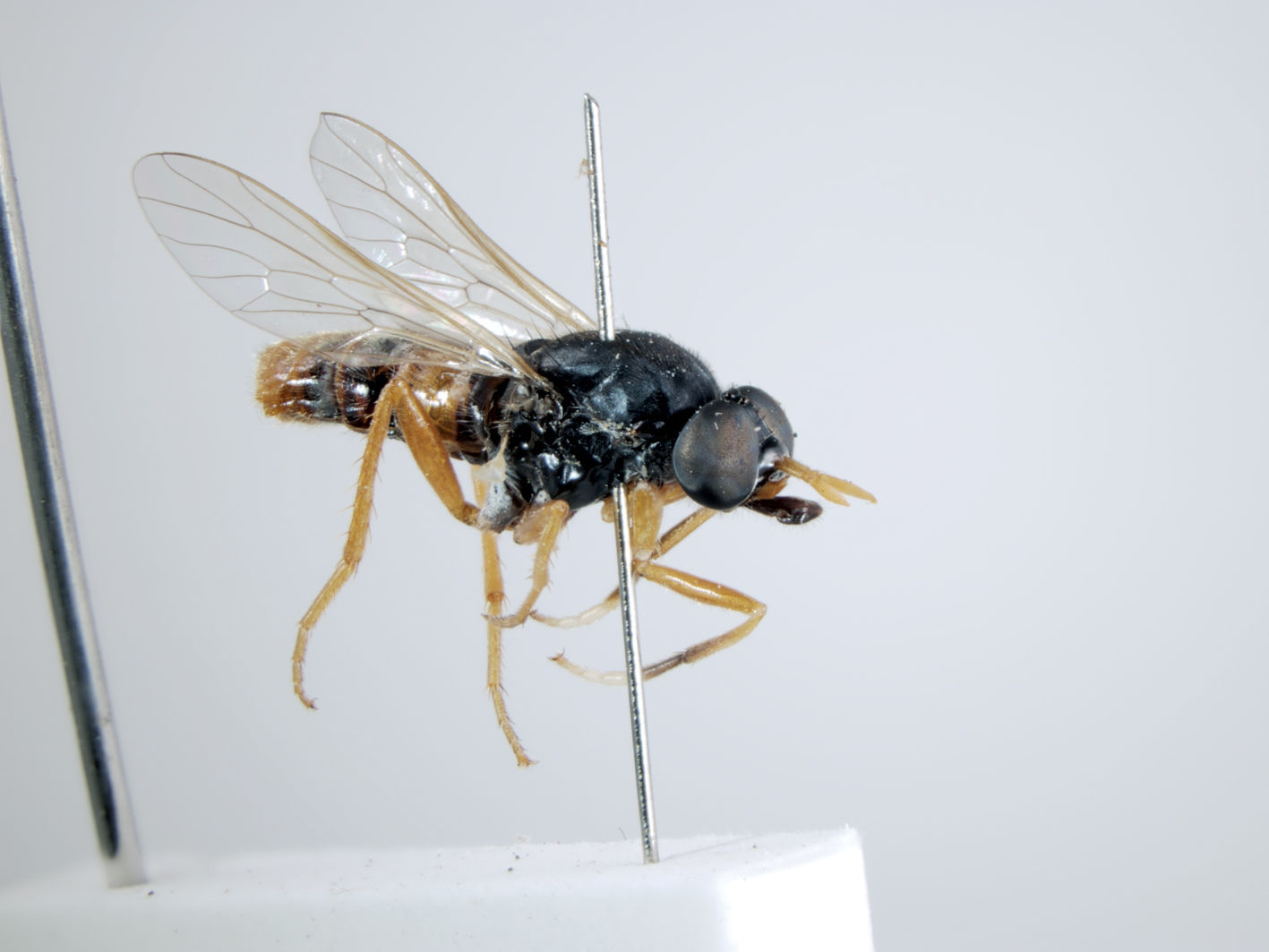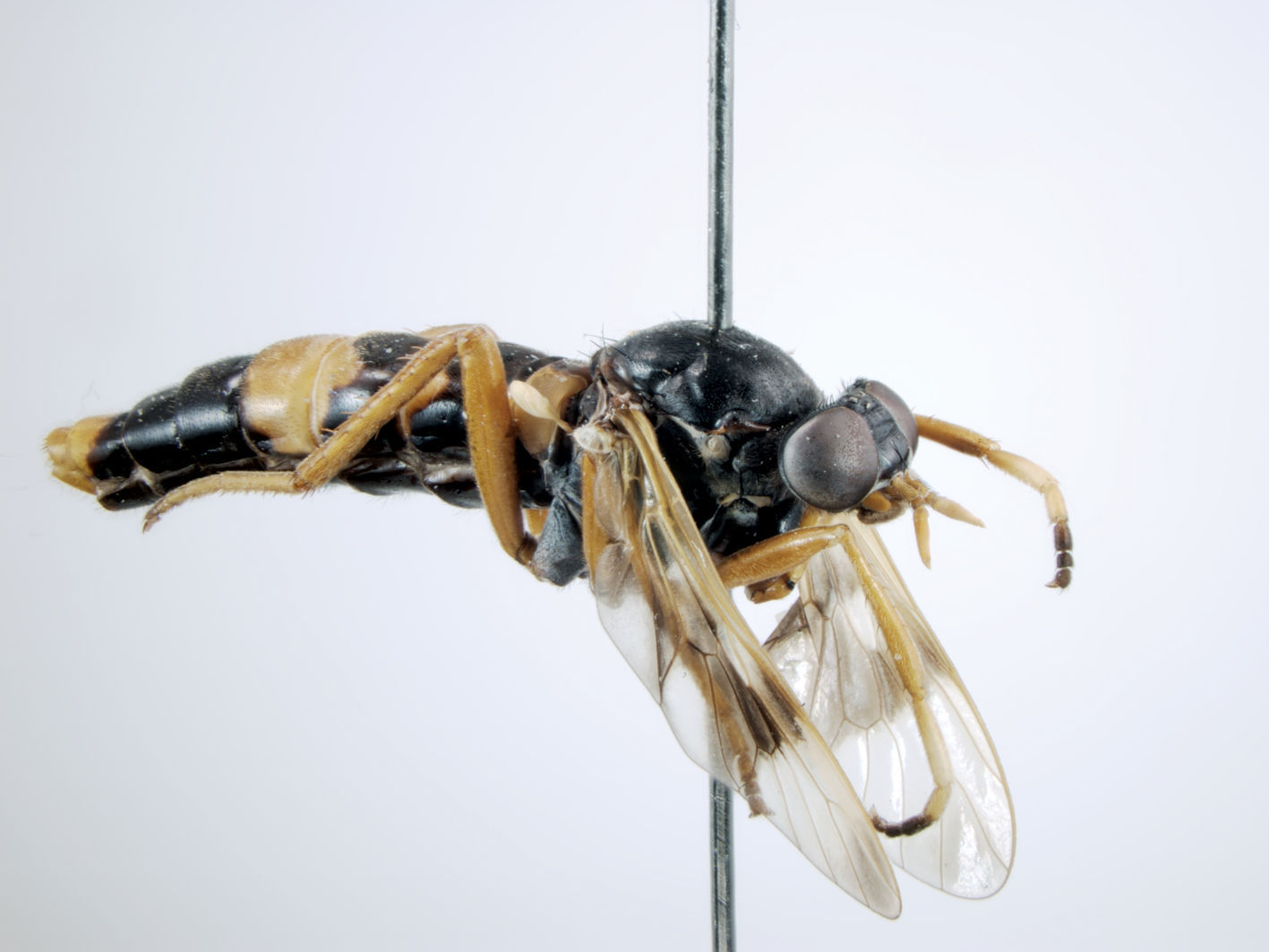






(C) 2010 Winterton Shaun L.. This is an open access article distributed under the terms of the Creative Commons Attribution License, which permits unrestricted use, distribution, and reproduction in any medium, provided the original author and source are credited.
For reference, use of the paginated PDF or printed version of this article is recommended.
Australian stiletto flies of the sister-genera Acupalpa Kröber, 1912 and Pipinnipons Winterton, 2001 (Diptera: Therevidae: Agapophytinae) are revised. Twelve new species of Acupalpa are described, while Acupalpa imitans (White, 1915), comb. n. is transferred from Pipinnipons and Acupalpa albimanis (Kröber, 1914), comb. n. is transferred from Ectinorhynchus Macquart as a senior synonym of Acupalpa pollinosa Mann. The total number of species of Acupalpa is therefore increased to 19: Acupalpa albimanis (Kröber), comb. n., Acupalpa albitarsa Mann, Acupalpa boharti sp. n., Acupalpa divisa (Walker), Acupalpa dolichorhyncha sp. n., Acupalpa glossa sp. n., Acupalpa imitans (White), comb. n., Acupalpa irwini Winterton, Acupalpa melanophaeos sp. n., Acupalpa miaboolya sp. n., Acupalpa minuta sp. n., Acupalpa minutoides sp. n., Acupalpa notomelas sp. n., Acupalpa novayamarna sp. n., Acupalpa rostrata Kröber, Acupalpa semirufa Mann, Acupalpa westralica sp. n., Acupalpa yalgoo sp. n. and Acupalpa yanchep sp. n. Three new species of Pipinnipons are described, increasing the total number of species to five: Pipinnipons chauncyvallis sp. n., Pipinnipons fascipennis (Kröber), Pipinnipons kampmeierae sp. n., Pipinnipons kroeberi Winterton, and P. sphecoda sp. n. Pipinnipons and Acupalpa are rediagnosed in light of the new species presented herein and revised keys to species are included. A dichotomous key to genera of Australasian Therevidae is included. As an empirical example of cybertaxonomy, taxonomic descriptions were composed using a character matrix developed in Lucid Builder (in Structured Descriptive Data (SDD) format) to generate natural language descriptions supplemented by online specimen and image databases. Web resources are provided throughout the document including: a) links to high resolution colour images of all species on Morphbank, b) registration of authors, publications, taxon names and other nomenclatural acts in Zoobank, with assignment of Life Science Identifiers (LSIDs) for each, c) links to Genbank accession records for DNA sequences, and d) assignment of LSIDs to specimen records with links to respective records in an online Therevidae specimen database.
cybertaxonomy, LSID, character matrix, natural language description
The stiletto fly subfamily Agapophytinae
is comprised of 23 described genera restricted in the Australasia
region, yet with three additional described genera endemic to Chile and
Argentina (
Twelve new species of Acupalpa are described herein: Acupalpa boharti sp. n., Acupalpa dolichorhyncha sp. n., Acupalpa glossa sp. n., Acupalpa melanophaeos sp. n., Acupalpa miaboolya sp. n., Acupalpa minuta sp. n., Acupalpa minutoides sp. n., Acupalpa notomelas sp. n., Acupalpa novayamarna sp. n., Acupalpa westralica sp. n., Acupalpa yalgoo sp. n., and Acupalpa yanchep
sp. n. Many of these species are from Western Australia, indicating a
rich diversity of this genus in the western region of the continent.
Addition of these new species significantly broadens the concept of Acupalpa beyond the characters defining the genus in previous treatments (i.e.
The modern taxonomic enterprise represents a gradual
paradigm shift away from tedious traditional methods toward rapid,
semi-automated ones (i.e. recently termed cybertaxonomy), with
increased efficiency in data handling through the use of online
databases for information such as label metadata, specimen images,
name registration, semantic mark-up and natural language descriptions
from character matrices (
Adult morphological terminology follows
Types are deposited in the following institutions and collections: Queensland Museum (Brisbane) (QM), Australian Museum (Sydney) (AMS), Australian National Insect Collection (Canberra) (ANIC), Senckenberg Deutsches Entomologisches Institut, Müncheberg, Germany (DEI), University of Queensland Insect Collection (Brisbane) (UQIC), University of California, Davis, Bohart Museum (UCDC), Western Australian Museum (Perth) (WAM), Michael E. Irwin private collection [to be ultimately housed in the California Academy of Sciences] (MEIC/CAS), Greg Daniels private collection [to be ultimately housed in the Australian Museum] (GDCB/AMS), Naturhistorisches Museum Wien, (NMW), Harvard University Museum of Comparative Zoology (MCZ), Oxford University Museum of Natural History (OUMNH), University of California, Riverside (UCR), Universität von Hamburg Zoologisches Institut und Zoologisches Museum (ZMUH).
All types have been examined. Numbers quoted with individual specimens
as MEI000000 are unique identifiers in the therevid database MANDALA and
are attached to each specimen as a yellow or white label (
Key to genera of Australasian Therevidae
The following key to genera supersedes those by
| 1 | Femora with multiple vestiture types, often with appressed, scale-like setae; strong macrosetae usually present on femora; two spermathecae in female, ventral apodeme of parameral sheath not forked, usually narrow, dorsal apodeme of parameral sheath well developed, usually broad and hood-like | subfamily THEREVINAE – 2 |
| – | Femora with only a single type of setae, often short and dark setae admixed with longer pale setae, never appressed or scale-like, macrosetae sometimes present; three spermathecae (rarely reduced to one or two); ventral apodeme of parameral sheath forked or anteriorly emarginate, never as single narrow apodeme; dorsal apodeme of parameral sheath usually forked or greatly reduced, rarely broad or hood-like | subfamily AGAPOPHYTINAE – 4 |
| 2 | Male frons narrow so that eyes almost contiguous medially; usually a single row of postocular setae dorsomedially in male; mid coxal pile present; wing cell m3 open or closed; femora with distinct appressed pile (Indonesia, Papua New Guinea) (relatively slender flies) | Irwiniella Lyneborg |
| – | Male frons usually wider than ocellar tubercle so that eyes widely separated; usually many rows of postocular setae dorsally in both sexes; mid coxal pile absent (rarely present in Anabarhynchus); wing cell m3 open; femora with multiple vestiture types, sometimes without distinct appressed pile (robust flies) | 3 |
| 3 | Size variable, but never uniformly black; (Australia, Papua New Guinea, New Caledonia, Fiji, New Zealand) | Anabarhynchus Macquart |
| – | Large, black, robust flies; female sternite 8 with posterolateral slits (New Zealand) | Megathereva Lyneborg |
| 4 | Elongate strip of velutum (velvet pubescence) on ventromedial surface of hind femur present; patch of velutum on ventral surface of male gonocoxite often present (rarely reduced or absent); wing cell m3 open or closed (Australia, Papua New Guinea, Indonesia) | 5 |
| – | Femora without of velutum patches; gonocoxites without velutum patch ventrally (rarely present); wing cell m3 open (Australia, New Zealand, Papua New Guinea, Indonesia, New Caledonia) | 18 |
| 5 | Wing cell m3 open | 6 |
| – | Wing cell m3 closed | 9 |
| 6 | Fore femur without velutum patch on ventral surface; hind femur with one (rarely more) subapical anteroventral seta; antennae usually longer than head, flagellum cylindrical; occiput often overlain with silver, gold and matte black pubescence (Australia) | Evansomyia Mann |
| – | Fore femur with velutum patch on ventral surface; hind femur without subapical setae; antennae usually shorter than head, flagellum conical; occiput not overlain with silver, gold and matte black pubescence | 7 |
| 7 | Short, relatively small flies; male genitalia with ventral lobe of male gonocoxite not broad or enlarged; medial atrium ( |
Parapsilocephala Krober (part) |
| – | Elongate, small to relatively large flies; ventral lobe of gonocoxite broad, enlarged; medial atrium absent | 8 |
| 8 | Eyes relatively small; occiput concave, postocular ridges angled, not in same plane; relatively few postocular setae, arranged in a poorly defined single row; setae absent on posterior surface of mid coxa; postspiracular setae absent; mid femur without elongate velutum patch; distiphallus spinose apically (Australia) | Belonalys Krober |
| – | Eyes regular size; occiput concave or convex, postocular ridges straight or almost in same plane, usually with multiple rows of postocular setae dorsally, some males with only a single row; setae sometimes present on prosternum, and on posterior surface of mid coxa; postspiracular setae sometimes present; additional elongate velutum patch on posteroventral surface of mid femur often present; distiphallus without spines (Australia) | Laxotela Winterton & Irwin |
| 9 | Flagellum elongate, narrow cylindrical in cross-section; scape also narrow elongate, usually more than 3? length of pedicel; antennae typically longer than head (rarely equal in length); antennae appear positioned on middle or upper region of head, rarely on lower frons; antennae usually not projecting anteroventrally to body axis | 10 |
| – | Flagellum conical, turbinate or oval shaped, usually flattened laterally; scape length variable but never elongate and narrow cylindrical, usually less than 3? pedicel length, sometimes bulbous; antennae shorter than head, although sometimes close to equal head length, antennae positioned very low on head and projecting anteroventrally to body axis | 12 |
| 10 | Flagellum shorter than or equal to scape length; scape usually longer than head (Australia, Papua New Guinea) | Agapophytus Guerin |
| – | Flagellum longer than scape length; scape never longer than head | 11 |
| 11 | Palpi spatulate; face narrow, not expansive or protruding (Australia) | Pipinnipons Winterton |
| – | Palpi narrow to acuminate, not broadened apically; face expansive and often protruding anteriorly (Australia) | Acupalpa Krober |
| 12 | Black individuals with silver-white velutum stripe along lower half of thorax and abdomen; male genitalia with articulated gonocoxal process absent or greatly reduced; ventral lobe greatly enlarged into blade-like structure (Australia) | Vomerina Winterton |
| – | Body colour and markings otherwise (silver velutum stripe on pleuron present in some genera); male genitalia with well-developed articulated gonocoxal process; ventral lobe not large and blade-like | 13 |
| 13 | Wing typically strongly banded; abdomen slender and narrow basally, diameter of thorax distinctly greater than base of abdomen; hind femur longer than fore and mid femora; male genitalia with medial atrium present or absent | 14 |
| – | Wing hyaline or variably infuscate, but not banded; abdomen thicker basally, diameter similar to thorax, slightly tapered posteriorly but not slender; femora approximately equal length male genitalia with medial atrium present | 16 |
| 14 | Male epandrium arched to partially conceal gonocoxites; medial atrium present between gonocoxites; hypandrium with patch of strong posteriorly directly setae (Australia) | Acatopygia Krober |
| – | Male epandrium not concealing gonocoxites; gonocoxites meeting medially such that medial atrium is absent; hypandrium without patch of strong setae | 15 |
| 15 | Small species (usually <6.0 mm body length); scutellum often dorsally acuminate; frequently excellent ant mimics; male with single row of postocular setae (Australia, Papua New Guinea, Timor) | Acraspisa Krober |
| – | Relatively larger species (8.0–12.0 mm body length), usually larger than 6.0mm total body length; scutellum rounded, never dorsally acuminate; male with multiple rows of postocular setae (Australia) | Acraspisoides Hill & Winterton |
| 16 | Ventral lobe very long and narrow, length equal to gonostylus; plate or cup-like velutum patch on gonocoxites; frons flattened or rounded, without callus above antenna (Australia) | Patanothrix Winterton |
| – | Ventral lobe shorter than gonostylus; velutum barely evident on gonocoxite, found mainly on atrium membrane; frons typically with glossy callus above antenna | 17 |
| 17 | Three spermathecae present; transverse velutum plaques absent on male abdomen; gonocoxal apodemes and distiphallus short; ejaculatory apodemes strongly sclerotized but not enlarged (Australia) | Parapsilocephala Krober (part) |
| – | One spermatheca present; transverse velutum plaques often present on male abdomen; gonocoxal apodemes and distiphallus often greatly elongate; ejaculatory apodemes greatly enlarged (Australia) | Bonjeania Irwin and Lyneborg |
| 18 | Hind femur without subapical setae | 19 |
| – | Hind femur with one (rarely more) subapical anteroventral seta | 20 |
| 19 | Male gonocoxite with processes absent; male usually with a single row of postocular setae dorsally; medium sized flies; colouration and markings variable, scutum often yellow or tan ground colour with dark brown tessellate or spotted pattern (Australia) | Neodialineura Mann |
| – | Male gonocoxite with gonocoxal process present; male usually with multiple poorly defined rows of postocular setae dorsally; relatively small flies; grey and black colouration and markings (Australia) | Manestella Metz |
| 20 | Body usually large to medium sized, robust, glossy dark metallic blue or orange; abdomen abruptly tapered; small patch of postspiracular setae present on thorax; wing extensively black (sometimes hyaline basally) or orange infuscate | 21 |
| – | Body size variable, usually relatively slender, never glossy metallic blue or orange; abdomen elongate, evenly tapered; thoracic postspiracular setae absent; wing infuscation variable, usually banded or hyaline, never uniform orange or black | 22 |
| 21 | Scape short, setae on antennae and head relatively short; two pairs of scutellar setae; wing with uniform orange infuscation (Australia) | Eupsilocephala Krober |
| – | Scape elongate with numerous enlarged setae; single pair of scutellar setae; wing either with uniform black infuscation or hyaline basally (Australia) | Johnmannia Irwin and Lyneborg |
| 22 | Male and female occiput convex, variously overlain with bronze, matte black, silver and gold pubescence; multiple rows of postocular setae in male; abdomen of equal diameter along length; distiphallus broad, cylindrical; medium to large individuals (Australia) | Taenogera Krober |
| – | Male occiput typically flat to concave, not distinctly convex, rarely overlain with bronze, matte black, silver and gold pubescence; usually single row of postocular setae in male; abdomen tapered; distiphallus usually narrow; size variable | 23 |
| 23 | Antennae shorter than or equal to head length; scape usually < 2? pedicel length, usually with only small setae on scape and frons | 24 |
| – | Antennae longer than head; scape > 3? pedicel length, often with strong setae on scape and frons | 25 |
| 24 | Occiput with multiple rows of postocular setae in both sexes; male with articulated gonocoxal process greatly reduced or absent; gonocoxite sometimes with large horn-like posterior process (Australia) | Actenomeros Winterton & Irwin |
| – | Occiput with single row of postocular setae in male; male with articulated gonocoxal process well developed; gonocoxite without horn-like posterior process (Australia) | Nanexila Winterton & Irwin |
| 25 | Occiput overlain with silver and matte black pubescence; male with single row of postocular setae; typically larger species with banded wings | 26 |
| – | Occiput overlain with grey pubescence; male often with multiple rows of postocular setae; smaller species with hyaline or slightly suffused wings (Australia) | Taenogerella Winterton & Irwin |
| 26 | Male with medial atrium between gonocoxites, articulated gonocoxal process greatly reduced; velutum patch present ventrally on gonocoxites; colouration and markings often sexually dimorphic (Australia, New Zealand) | Ectinorhynchus Macquart |
| – | Male without medial atrium between gonocoxites, articulated gonocoxal process well developed; velutum absent on gonocoxites; colouration and markings not sexually dimorphic (Australia, Papua New Guinea) | Squamopygia Krober |
urn:lsid:zoobank.org:act:68450BF4-0179-4194-BE8D-422966FC95C7
http://species-id.net/wiki/Acupalpa
Antennal scape shorter than or equal to flagellum; antenna elongate, cylindrical, total length slightly longer than or equal to head length; upper part of frons flat or slightly concave above antenna; face either protruding anteriorly below antennal base, or broadly rounded, expansive, short dark setae often present; parafacial setae absent; palpus apically narrow or acute, not spatulate; mouthparts length variable, frequently elongate and forward projecting (Fig. 3H); male postocular ridge with single row of macrosetae immediately laterad of ocellar tubercle, female with more than one row; wing infuscate, usually strongly banded; setae absent on wing vein R1; cell m3 closed; velutum patches on fore and hind femora; femora without macrosetae; single type of setal pile on femora, setae not appressed; prosternal furrow without setae; post spiracular pile absent; pleuron orange to black, overlain with sparse silver pubescence; mid coxa without setae on posterior surface; gonocoxites with velutum patch on ventral surface (Fig. 3B); articulated gonocoxal process present; hypandrium present; ventral apodeme of parameral sheath forked; dorsal apodeme of parameral sheath ‘T’-shaped (Fig. 3F); three spermathecae in female; spermathecal sac present, sac simple or with smaller additional lobes basally, often with outer elongate lobes; spermathecal ducts joining common duct before bursa (Fig. 3G), female with A1 and A2 acanthophorite spines well developed; female sternite 8 emarginate along posterior margin.
Acupalpa divisa(Walker), female, Brisbane, Queensland. Body length= 7.0 mm. (Photo: Anthony O’Toole, University of Queensland).
Acupalpa yanchep sp. n., female, Yanchep, Western Australia. Body length= 9.0 mm. (Photo: S.L. Winterton).
Acupalpa spp.: A Acupalpa notomelas sp. n., epandrium dorsal B gonocoxites, ventral C Acupalpa imitans (White), comb. n., gonocoxite, lateral D same, aedeagus, lateral E Acupalpa rostrata Kröber aedeagus, lateral F Acupalpa imitans, gonocoxites, epandrium removed and aedeagus in situ, dorsal G Acupalpa rostrata, female spermathecal sac complex, dorsal H Acupalpa melanophaeos sp. n., female head, lateral I Acupalpa rostrata, male head, anterolateral. Abbreviations: ag accessory gland c cercus d distiphallus da dorsal apodeme of parameral sheath ea ejaculatory apodeme f furca ga gonocoxal apodeme gp (articulated) gonocoxal process gs gonostylus gx gonocoxite h hypandriumgp gonocoxal process (articulated) lea lateral ejaculatory apodeme s spermatheca ss spermathecal sac ssd spermathecal sac duct va ventral apodeme of parameral sheath v velutum patch vl ventral lobe. Scale lines = 0.2 mm.
Acupalpa is a genus with some distinctive wasp mimicking species (Figs 1–2), often strikingly coloured with black and orange. The male terminalia are relatively conserved throughout both Acupalpa and Pipinnipons, and species identification is more easily and reliably accomplished using external characters of either sex. Closely related to Pipinnipons and Agapophytus, Acupalpa can be distinguished by the elongate, cylindrical antennae, scape not longer than flagellum, face usually expansive and protruding, and palpi that are acuminate or narrowly cylindrical. The latter two characters specifically differentiate Acupalpa from Pipinnipons, as the face is always narrow and the palpi spatulate in Pipinnipons. Agapophytus is separated from Pipinnipons and Acupalpa by the length of the scape ranging from relatively equal length, to significantly longer than the flagellum.
Acupalpa albimanis (Kröber), comb. n., Acupalpa albitarsa Mann, Acupalpa boharti sp. n., Acupalpa divisa (Walker), Acupalpa dolichorhyncha sp. n., Acupalpa glossa sp. n., Acupalpa imitans (White), comb. n., Acupalpa irwini Winterton, Acupalpa melanophaeos sp. n., Acupalpa miaboolya sp. n., Acupalpa minuta sp. n., Acupalpa minutoides sp. n., Acupalpa notomelas sp. n., Acupalpa novayamarna sp. n., Acupalpa rostrata Kröber, Acupalpa semirufa Mann, Acupalpa westralica sp. n., Acupalpa yalgoo sp. n., Acupalpa yanchep sp. n.
Key to Acupalpa species
| 1 | Abdomen ground colour completely brown to black (terminal segments sometimes orange in female) (e.g. Figs 5, 10, 16) | 2 |
| – | Abdomen with any number of segments 1–3 completely or partially orange or yellow (e.g. Figs 7–9, 11–12) | 11 |
| 2 | Fore and mid coxae brown to black, overlain with silver-grey pubescence (e.g. Figs 5–6, 13, 18) | 4 |
| – | Fore and mid coxae orange to pale yellow (Figs 16, 20) | 3 |
| 3 | Lower pleuron orange; fore femur brown; base of mid and hind femora orange; foreleg second tarsomere pale (Fig. 16) | Acupalpa notomelas sp. n. |
| – | Pleuron uniformly brown to black; fore and mid femora brown to black dorsally, pale ventrally; hind femur brown to black; foreleg second tarsomere brown to black (female only) (Fig. 20) | Acupalpa westralica sp. n. |
| 4 | Scape and pedicel yellow; fore and mid femora yellow (Fig. 18) | Acupalpa rostrata (Krober) |
| – | Scape and pedicel brown to black (rarely pale basally); fore and mid femora brown to black | 5 |
| 5 | Very small sized species (< 3.5 mm total body length); pleuron with longitudinal stripe of silver velutum; flagellum grossly enlarged (> 3 time combined scape and pedicel length) (Fig. 14); two notopleural macrosetae | 6 |
| – | Size variable, but usually larger than 5.0 mm; pleuron colour and vestiture variable but never with longitudinal silver velutum stripe; flagellum length sub-equal to 0.5 times combined scape and pedicel length; always more than two notopleural macrosetae | 7 |
| 6 | Coxal macrosetae pale; frons width slightly narrower than ocellar tubercle width; wing vein M1 and M2 originating separately from discal cell; fore tibia uniformly brown to black (Fig. 14) (male only) | Acupalpa minuta sp. n. |
| – | Coxal macrosetae black; male frons slightly wider than ocellar tubercle width; wing vein M1 and M2 fused basally and originating as a petiolate stem from discal cell; fore tibia yellowish basally (Fig. 15) (male only) | Acupalpa minutoides sp. n. |
| 7 | Fore tibia pale yellow to white, rarely brown distally; male abdomen without silver velutum; small species (Figs 6, 13) | 8 |
| – | Fore tibia dark, rarely pale basally; male abdomen with silver velutum; larger species (Figs 5, 22) | 9 |
| 8 | Scutum overlain with mostly uniform brown-bronze pubescence; fore tibia uniform white-cream (Fig. 6) | Acupalpa boharti sp. n. |
| – | Scutum overlain with grey and brown striped pubescence; fore tibia white-cream, but darker basally (Fig. 13) | Acupalpa miaboolya sp. n. |
| 9 | Basitarsi white to cream, fore-basitarsus darker basally, all tarsomeres 3–5 dark (Fig. 4) | Acupalpa albimanis (Krober), comb. n. |
| – | Basitarsi brown to black, tarsomeres 2–5 white | 10 |
| 10 | Male frons at narrowest point slightly narrower than width of ocellar tubercle (western Australia) (Figs 2, 22) | Acupalpa yanchep sp. n. |
| – | Male frons approximately equal width to ocellar tubercle at narrowest point (eastern Australia) (Fig. 5) | Acupalpa albitarsa Mann |
| 11 | Femora pale yellow to orange (Figs 9–10, 12, 17, 19) | 12 |
| – | Femora brown to black (Figs 7–8, 11, 21) | 16 |
| 12 | Coxae pale orange; pleuron dark with orange suffusion; male abdomen without silver velutum (Figs 12, 17) | 13 |
| – | Coxae dark (rarely dark orange), overlain with silver-grey pubescence; pleuron completely dark, overlain with silver pubescence; male abdomen with or without silver velutum dorsally (Figs 9–10, 19) | 14 |
| 13 | Pleuron mostly dark; scutal setae minute; genal setae dark; male frons width equal to width of anterior ocellus (Fig. 12) | Acupalpa melanophaeos sp. n. |
| – | Pleuron mostly orange; scutal setae medium length; genal setae pale; male frons width equal to width of ocellar tubercle (Fig. 17) | Acupalpa novayamarna sp. n. |
| 14 | Tibia and tarsi mostly darkened apically; frons profile concave; male abdomen with dense silver velutum dorsally (Fig. 19) | Acupalpa semirufa Mann |
| – | Tibia and tarsi without distinctive darkening apically; frons profile rounded; male abdomen without dense silver velutum dorsally | 15 |
| 15 | Abdominal segments 2–3 bright orange, with orange suffusion of segments 1 and 4; haltere knob brown (Fig. 9) | Acupalpa glossa sp. n. |
| – | Abdominal segments 2–3 slight orange-tan laterally; haltere knob white (Fig. 10) | Acupalpa imitans (White), comb. n. |
| 16 | Tibia brown to black (Figs 7–8) | 17 |
| – | Tibia yellow to cream basally, dark apically (Figs 11, 21) | 18 |
| 17 | Mouthparts greatly elongate, much longer than head length; foreleg basitarsus entirely white to cream (Fig. 8) | Acupalpa dolichorhyncha sp. n. |
| – | Mouthparts approximately equal to head length; foreleg basitarsus darker basally, pale distally (Fig. 7) | Acupalpa divisa (Walker) |
| 18 | Antennal scape and face with short, dark setae; face flat, not protruding anteriorly (male only) (Fig. 21) | Acupalpa yalgoo sp. n. |
| – | Antennal scape and face with pale setae; face protruding anteriorly (Fig. 11) | Acupalpa irwini Winterton |
urn:lsid:zoobank.org:act:911E11F8-66AF-41CF-9B32-8C4B4D744C6A
http://species-id.net/wiki/Acupalpa_albimanis
Fig. 4Ectinorhynchus albimanus Kröber, 1914 - Holotype female ‘N. Holl. [Neu Holland] 878 IV/ TYPE (ANIC29_003432) (NMW).
Acupalpa pollinosa Mann, 1929 - Holotype male, AUSTRALIA: Queensland: Brisbane, 18.ix.1914, H. Hacker (MEI029468) [D3283] (QM). Paratypes: AUSTRALIA: Queensland: 2 males, Brisbane, 24.ix.1914, 24.ix.1923, H. Hacker (MEI108792, 108793) (QM).
Frons profile concave above antenna; antenna black; wing dark banded; legs black with basitarsus and second tarsomere white; abdomen black, overlain with silver velutum in male.
Body length= 6.9–9.3 mm. Head. Frons wider than ocellar tubercle, profile transversely concave above antennae, pubescence as two silver patches along eye margin, vestiture as minute setae; frons surface texture as irregular longitudinal striations; face projecting anteriorly, vestiture with dark to pale setae; gena with pale setae; parafacial glabrous; mouthparts relatively short (approximately equal to head length); palpus brown-black, acuminate; occiput glabrous, glossy black; antennal base raised; antennal length approximately equal to head; scape brown to black, length much shorter than flagellum, with sparse black setae ventrally; flagellum black, base of flagellum with short, dark setae. Thorax. Scutum uniform grey-black; scutellum overlain with dense, matt-black pubescence; pleuron black, overlain with sparse silver-grey pubescence; wing markings dark banded infuscate; haltere knob white, stem dark brown; coxae and femora brown to black; tibia dark; tarsi dark, basal ¾ of fore-basitarsus and entire second tarsomere cream to white. Scutal chaetotaxy (macrosetae pairs): np (notopleural), 4; sa (supra-alar), 1; pa (post-alar), 1; dc (dorsocentral), 2–3; sc (scutellar), 1. Abdomen. Black, covered with silver velutum dorsally on tergites (male only); terminalia pale.
Acupalpa albimanis (Kröber), comb. n., (Holotype of Acupalpa pollinosa), male, anterolateral view [Morphbank: 576222]. Body length = 6.5 mm.
Ectinorhynchus albimanis is herein transferred to Acupalpa with Acupalpa pollinosa becoming a junior synonym of Acupalpa albimanis comb. n.
urn:lsid:zoobank.org:act:44480644-4D44-460F-9092-7E610A4767F0
Genbank Accession: AF150967
http://species-id.net/wiki/Acupalpa_albitarsa
Fig. 5Holotype male, AUSTRALIA: Queensland: Brisbane, 24.ix.1914, H. Hacker [-27.465, 153.017] (MEI029448) [D3282] (QM). Paratypes: AUSTRALIA: Queensland: 4 males, same data as holotype, (MEI108766, 108768, 108770, 108771) (QM).
Frons profile rounded above antenna; antenna black, scape sometimes brown; wing irregularly banded; pleuron black; tarsi white with brown to black basitarsus; abdomen with sparse silver velutum on anterior segments (denser in male).
Body length= 7.4–9.7 mm. Head. Frons wider than ocellar tubercle; profile rounded above antenna, pubescence sparse silver-grey; frontal vestiture as minute setae, texture verrucous; face shape broadly rounded, vestiture with dark or pale setae; gena with pale setae; parafacial glabrous; mouthparts elongate and projecting anteriorly, or relatively short; palpus brown-black, acuminate; occiput glabrous, glossy black; antennal base raised; antenna longer than head; scape brown or black, length approximately equal to flagellum, with sparse black setae; flagellum black, base of flagellum with short, dark setae. Thorax. Scutum light grey to black, setal bases glossy black; scutellum overlain with dense, matt-black pubescence; pleuron black, overlain with sparse, silver-grey pubescence; wing markings irregularly banded; haltere knob white; coxae black; femora brown to black; tibia dark, lighter basally; tarsi white with basitarsi dark. Scutal chaetotaxy: np, 3–4; sa, 1; pa, 1; dc, 2–3; sc, 1. Abdomen. Entirely black, segments 5–8 sometimes orange dorsally; silver velutum dorsally on tergites (1–3), bronze medially; terminalia dark (male) or pale (female).
Acupalpa albitarsa Mann, male, anterolateral view [576246]. Body length = 7.0 mm.
The distinctive tarsal colouration of Acupalpa albitarsa and the closely related Acupalpa yanchep sp. n., separates these species from all other Acupalpa. Acupalpa albitarsa is an eastern species while Acupalpa yanchep sp. n. is western. Females are difficult to distinguish but males differ in the shape of the frons and in general body shape and size. The white patterning of the scutum is less pronounced in this species.
urn:lsid:zoobank.org:act:8F89524D-85C5-4332-86AC-D278AB724C1D
http://species-id.net/wiki/Acupalpa_boharti
Fig. 6Holotype female, AUSTRALIA: Western Australia: Norseman, [-32.167°, 121.75°], 24.xi.1979, R. M. Bohart (MEI029500) (UCDC). Paratypes. AUSTRALIA: Western Australia: male, female, Norseman, [-32.167°, 121.75°], 24.xi.1979, R. M. Bohart (MEI029499, 029501) (UCDC).
Body size relatively small; frons rounded above antenna; scutum glossy black with bronze pubescence; tibia yellow with dark apices, fore tibia white-cream; abdomen black, without velutum.
Body length= 5.0–6.0 mm. Head. Frons wider than ocellar tubercle, profile rounded above antenna, glabrous; frontal vestiture as minute setae, texture smooth; face broadly rounded, glabrous; gena with pale setae; parafacial glabrous; mouthparts elongate, projecting anteriorly, or sometimes relatively short; palpus brown-black, acuminate; occiput glabrous, glossy black; antennal base flat; frons roughly level with eye in profile; antenna longer than head; scape brown or black, length shorter than flagellum, with sparse black setae; flagellum black or brown, base of flagellum with short dark setae. Thorax. Scutum glossy black, overlain with sparse bronze pubescence; scutellum overlain with dense, matt-black pubescence; pleuron black, overlain with sparse, silver-grey pubescence; wing markings weakly infuscate with pale band midway, hyaline ocellations basally; haltere knob orange-yellow; coxae black; femora brown to black; tibia yellow, apices dark on mid and hind tibia, fore tibia white-cream; tarsi black; mid and hind basitarsi pale basally. Scutal chaetotaxy: np, 4; sa, 1; pa, 1; dc, 4–6; sc, 1. Abdomen. Black, silver velutum absent, terminalia dark.
Acupalpa boharti sp. n., female, lateral view [576266]. Body length = 5.0 mm.
Acupalpa boharti sp. n. is a small, dark species similar to Acupalpa miaboolya sp. n. This species is known only from the type series collected in southwestern Australia. The small body size and leg and body colouration are diagnostic for this species.
This species is named in honour of the collector, R. M. Bohart.
urn:lsid:zoobank.org:act:318DBAA4-B88A-4276-897B-643F78FA4AA5
Genbank Accession: AF150966
http://species-id.net/wiki/Acupalpa_divisa
Fig. 7 Dimassus divisus
Acupalpa semiflava
AUSTRALIA: Queensland: male, Barakula State Forest, Hellhole Creek, Auburn Rd., 52062, 13.x.2004, Queensland Museum party, open forest, hand collected [-26.33°, 150.7°] (ANIC29_016460) (QM).
Frons profile concave above antenna; antenna black; pleuron black; wing dark banded; femora and tibia black; abdomen black, segments 1–3 yellow at least laterally; abdominal velutum present in male.
Body length= 6.5–8.0 mm. Head. Frons wider than ocellar tubercle, profile transversely concave above antennae, pubescence as silver patches along eye margin, frontal vestiture as minute setae, texture as irregular longitudinal striations; face produced anteriorly, vestiture with dark or pale setae; gena with pale setae; parafacial glabrous; mouthparts elongate, projecting anteriorly, or sometimes relatively short; palpus brown-black, acuminate; occiput glabrous, glossy black; antennal base raised, antennal length approximately equal to head; scape black, length approximately equal to flagellum, with sparse black setae; flagellum black, base of flagellum with short dark setae. Thorax. Scutum uniform grey-black, sometimes with faint white stripes; scutellum overlain with dense, matt-black pubescence; pleuron black, overlain with sparse silver-grey pubescence; wing markings dark banded infuscate; haltere knob white; coxae black; femora brown to black; tibia black; tarsi black; fore basitarsus white distally, 2nd tarsomere basally, remaining basitarsi yellowish. Scutal chaetotaxy: np, 4; sa, 1; pa, 1; dc, 3–4; sc, 1. Abdomen. Segments 2–3 yellow, remaining segments black (male tergites 1-3 dark medially), silver velutum dorsally on tergites (male) or absent (female); terminalia dark.
Acupalpa divisa (Walker), male, anterolateral view [576245]. Body length = 7.0 mm.
The male of Acupalpa divisa has long been unknown, and herein described for the first time.
urn:lsid:zoobank.org:act:56FF95E1-D936-4DBA-8EBF-3A6E79B24116
http://species-id.net/wiki/Acupalpa_dolichorhyncha
Fig. 8Holotype male, AUSTRALIA: Western Australia: 11 km N Cataby, 29.x.1987, M. E. Irwin & E. I. Schlinger, sweeping Leptospernum flowers [-30.733°, 115.533°] (MEI029507) (ANIC). Paratype. AUSTRALIA: Western Australia: female, same data as holotype (MEI029506) (ANIC).
Mouthparts elongate; frons profile rounded above antenna; antenna black; scutum glossy black; pleuron black; wing dark banded; abdominal segments 1–3 orange, rest black; abdominal velutum absent.
Body length= 7–10 mm. Head. Frons wider than ocellar tubercle (male), profile rounded above antenna, pubescence absent, glabrous, frontal vestiture glabrous or as minute setae, surface texture smooth; face shape broadly rounded, expansive, vestiture with dark or pale setae; gena with pale setae; parafacial glabrous; mouthparts elongate, projecting anteriorly; palpus brown-black, narrowly cylindrical; occiput overlain with sparse, silver-grey pubescence; antennal base flat, frons roughly level with eye in profile; antennal length approximately equal to head; scape black with sparse black setae, length shorter than flagellum; flagellum black, base of flagellum with short dark setae. Thorax. Scutum glossy black, overlain with faint stripes of grey pubescence; scutellum overlain with dense, matt-black pubescence; pleuron black, overlain with sparse silver-grey pubescence; wing markings faintly banded infuscate; haltere knob white; coxae black; femora brown to black; tibia brown or black; tarsi dark, basitarsi pale, dark distally, fore-basitarsus entirely white. Scutal chaetotaxy: np, 4; sa, 1; pa, 1; dc, 2; sc, 1. Abdomen. Segments 1-3 orange, remaining segments black, silver velutum absent; terminalia dark.
Acupalpa dolichorhyncha sp. n., male, anterolateral view [576248]. Body length = 8.0 mm.
Acupalpa dolichorhyncha sp. n. is a distinctive species with elongate mouthparts and orange-banded abdominal segments 1–3. This western species is morphologically similar to Acupalpa melanophaeos sp. n., also from Western Australia, and Acupalpa glossa sp. n. from Victoria.
The specific epithet is derived from Gr. dolichos, long; rhynchus, snout, referring to the elongate mouthparts.
urn:lsid:zoobank.org:act:60BC378C-1247-4CB5-A194-755C00BC5567
http://species-id.net/wiki/Acupalpa_glossa
Fig. 9Holotype male, AUSTRALIA: Victoria: 5 km S Rocket Lake, Murray-Sunset N.P., 34.39°S, 141.49°E, 25.xi.1992, swept, McEvey, Moulds, McAlpine (MEI165183) (AMS). Paratypes. AUSTRALIA: Victoria: male, 2 females, Murray-Sunset N.P., Millewa South Bore track, 20.7 km S Shearers Quarters, 17–23.xi.2002, C. Lambkin, D. Yeates, N. Starick, J. Recsei, 34°45'02"S, 141°03'56"E [Malaise trap] (MEI165184, 165185, 165186) (ANIC).
Frons profile rounded above antenna; antenna black; scutum glossy black; pleuron orange to brown, darker posteriorly; wing banded infuscate; femora orange; tibia black; abdomen black, without velutum.
Body length= 7.0–9.0 mm. Head. Frons wider than ocellar tubercle, profile rounded above antenna, glabrous, sometimes with silver patches of pubescence along eye margin, frontal vestiture as minute setae, surface texture smooth; face broadly rounded, vestiture as dark or pale setae; gena with pale setae; parafacial glabrous; mouthparts elongate, projecting anteriorly; palpus brown-black, narrowly cylindrical; occiput overlain with sparse, silver-grey pubescence; antennal base flat; antennal length approximately equal to head; scape brown, shorter than flagellum, with sparse black setae; flagellum black, base of flagellum with short dark setae. Thorax. Scutum black, overlain with grey pubescence; scutellum overlain with dense, matt-black pubescence; pleuron dark, overlain with sparse silver-grey pubescence, denser anteriorly and posteriorly, sparse around midway; wing banded infuscate; haltere knob white; coxae dark, overlain with dense silver pubescence; femora orange; tibia orange, darker distally; fore basitarsus white, 2nd tarsomere white basally, remaining basitarsi cream, darker distally. Scutal chaetotaxy: np, 4; sa, 1; pa, 1; dc, 2; sc, 1. Abdomen. Segments 2–3 orange, rest black, intersegmental membranes white on segments 2–3, silver velutum absent; terminalia dark.
Acupalpa glossa sp. n., male, anterolateral view [576249]. Body length = 8.0 mm.
Acupalpa glossa sp. n. is similar to Acupalpa dolichorhyncha sp. n. in colour pattern and elongated mouthparts, but is easily differentiated based on leg colour. This species is known only from the type series collected in Victoria.
The specific epithet is derived from Gr. glossa, tongue, referring to the elongate mouthparts.
urn:lsid:zoobank.org:act:749A106A-0357-4AAF-A88B-E2E46ECA7B9A
http://species-id.net/wiki/Acupalpa_imitans
Figs 3C–D, F, 10Type female, AUSTRALIA: Tasmania: Wedge Bay, 3.i.1914, G.H. Hardy [lost].
Neotype male, AUSTRALIA: Queensland: Indooroopilly, Long Pocket [-27.418°, 152.837°], 22.viii–7.ix.2007, S. L. Winterton, Malaise trap (MEI165187) (QM).
AUSTRALIA: Queensland: female, Brisbane Forest Park, Scrub Road, crossing at Enoggera Creek, [-27.428°, 152.843°], 200m, 10–14.xi.1995, malaise trap, M.E. Irwin. (MEI140857) (QM); male, Tambourine, [-27.88, 153.13], 12.vi.1925 (“Allotype” of
Frons profile rounded above antenna; antenna dark yellow; pleuron black; wing dark banded; femora orange to yellow; tibia yellow; abdomen dark, segments 2–3 red-brown laterally, without silver velutum.
Body length= 6.3–7.0 mm. Head. Frons wider than ocellar tubercle (female) or narrower (male), profile rounded above antenna, pubescence as silver patches along eye margin, frontal vestiture glabrous, surface texture as irregular longitudinal striations or smooth; face as narrow strip below antennal base, vestiture glabrous; gena with pale setae; parafacial glabrous; mouthparts relatively short (approximately equal to head length); palpus brown-black, narrowly cylindrical; occiput glabrous, glossy black; antennal base flat, frons roughly level with eye in profile (or near so); antenna longer than head; scape dark yellow, length approximately equal to flagellum, scape with sparse black setae; flagellum dark yellow, base of flagellum with short dark setae. Thorax. Scutum black, overlain with grey pubescence, brown stripes of pubescence more expansive posteriorly; scutellum overlain with dense, matt-black pubescence; pleuron black, overlain with sparse silver-grey pubescence; wing markings banded infuscate; haltere knob white; coxae black; femora orange or yellow; tibia yellow, apices sometimes dark; tarsi yellow, fore-basitarsus white. Scutal chaetotaxy: np 4–5; sa, 1; pa, 1; dc, 2; sc, 1. Abdomen. Dark, segments 2–3 red-brown medially, orange laterally, silver velutum absent (female) or small triangular patches on tergites 2–3 (male); terminalia pale.
Acupalpa imitans (White), male, anterolateral view [576250]. Body length = 7.0 mm.
The type of Phycus imitans
was kept in the G.H. Hardy collection, which was moved from Brisbane
to Katoomba, but is now apparently lost or destroyed by pests. While
not stating whether he actually examined the type,
urn:lsid:zoobank.org:act:6C3A49B8-6E77-4C55-B5D9-C77636280ECB
http://species-id.net/wiki/Acupalpa_irwini
Fig. 11Holotype female, AUSTRALIA: Western Australia: 7.5 km WSW Lake Cronin, 32°23’S, 119°46’E, 19–26.ix.1978, T. F. Houston et al. (MEI029876) (WAM). Paratypes. AUSTRALIA: Western Australia: female, same data as holotype, (MEI029877) (WAM); male, 3 females, 53 km E Hyden nr. Emu Rock, 24–27.x.1985, R. W. Thorpe (MEI029502, 029503, 029504, 029505) (UCDC).
Frons profile rounded above antenna; face projecting anteriorly; antenna black; scutum grey to black; pleuron black; wing dark banded; femora brown to black; abdomen black, segments 1–3 orange; abdominal velutum absent.
Body length= 7.0–10.0 mm. Head. Frons wider than ocellar tubercle, profile rounded above antenna, pubescence sparse silver-grey, frontal vesiture small dark setae, surface texture verrucous; face projecting anteriorly, vestiture with dark or pale setae; gena with pale setae; parafacial glabrous or with pale setae; mouthparts elongate, projecting anteriorly; palpus brown-black, narrowly cylindrical; occiput overlain with sparse, silver-grey pubescence; antennal base raised; antennal length approximately equal to head; scape black, length approximately equal to flagellum, scape with pale setae ventrally, shorter dark setae dorsally; flagellum black, base of flagellum with short dark setae. Thorax. Scutum light grey to black, setal bases glossy black; scutellum overlain with dense, matt-black pubescence; pleuron black, overlain with silver-grey pubescence; wing markings dark banded infuscate; haltere knob brown; coxae black; femora brown to black; tibia yellow-orange, darker distally; tarsi black, basitarsi pale, dark distally. Scutal chaetotaxy: np, 4; sa, 1; pa, 1; dc, 2–3; sc, 1. Abdomen. Segments 1–3 orange, remaining segments black, silver velutum absent; terminalia dark.
Acupalpa irwini Winterton, female, anterolateral view [576251]. Body length = 9.0 mm.
Acupalpa irwini is a relatively large species differentiated by the characteristic leg and abdomen colouration. This species is known only from the type series collected in Western Australia.
urn:lsid:zoobank.org:act:32E2D131-5108-46B5-B330-ABEAAC192948
http://species-id.net/wiki/Acupalpa_melanophaeos
Figs 3H, 12Holotype female, AUSTRALIA: Western Australia: Drummond Cove, Geraldton, 16.xi.1973, N. McFarland [-28.767°, 114.617°] (MEI029498 ) (ANIC). Paratypes. AUSTRALIA: Western Australia: female, same data as holotype (MEI029496) (WAM); male, Bunbury, 3.i.1957, A. Snell [-33.317°, 115.633°] (MEI029509) (ANIC); female, Cape Le Grand Nat. Park [-33.96°, 122.12°], 12.i.1987, G. & A. Daniels (MEI029494) (GDCB/AMS).
Frons profile rounded above antenna; scape yellow, flagellum dark; scutum grey to black; pleuron black (reddish posteriorly in female); wing banded infuscate; coxae orange; legs orange to yellow, tarsi dark distally and fore-basitarsus white; abdomen black, segments 1–3 orange to yellow; abdominal velutum absent.
Body length= 7.1–9.6 mm. Head. Frons wider than ocellar tubercle (female) or narrower (male), profile rounded above antenna, pubescence absent, frontal vestiture glabrous or with minute setae, surface texture smooth; face shape broadly rounded, expansive, vestiture glabrous; gena with dark setae; parafacial glabrous; mouthparts elongate, projecting anteriorly, or sometimes relatively short; palpus brown-black, narrowly cylindrical; occiput glabrous, glossy black; antennal base raised (male) or flat, frons roughly level with eye in profile (female); antenna longer than head; scape yellow, length much shorter than flagellum, scape with short, black setae; flagellum black, base of flagellum with short, dark setae. Thorax. Scutum light grey to black, setal bases glossy black; scutellum overlain with dense, matt-black pubescence; pleuron black (male) or darker anteriorly with dark orange posteroventrally (female), overlain with sparse silver-grey pubescence; wing markings banded infuscate; haltere knob brown; coxae orange; femora orange or dark yellow; tibia orange; tarsi yellow orange, dark distally, fore-basitarsus white. Scutal chaetotaxy: np, 4; sa, 1; pa, 1; dc, 1–2; sc, 1. Abdomen. Segments 1–3 yellow or orange, remaining segments black, silver velutum absent; terminalia dark.
Acupalpa melanophaeos sp. n., female, anterolateral view [576252]. Body length = 9.0 mm.
Acupalpa melanophaeos sp. n.is a relatively large species from Western Australia with distinctive leg and abdomen colouration. It is morphologically similar to Acupalpa novayamarna sp. n. and Acupalpa notomelas sp. n. The coxae are pale in this species along with a rounded face, rather than protruding anteriorly in similar species (e.g. Acupalpa irwini).
The specific epithet is derived from theGr. melanos, black; phaeos, light, shiny, referring to the scutum colouration.
urn:lsid:zoobank.org:act:31A86965-E8AB-4D6C-9252-FE42BAC3269A
http://species-id.net/wiki/Acupalpa_miaboolya
Fig. 13Holotype male, AUSTRALIA: Western Australia: 14.5 km N Carnarvon, Miaboolya Beach, [-24.76°, 113.65°], 4.x.1969, H. E. Evans, R. W. Matthews. (MEI080305) (ANIC). Paratype. AUSTRALIA: Western Australia: female, same data as holotype (MEI080301) (MCZ).
Frons profile rounded above antenna; antenna brown to black; scutum glossy black with pubescent stripes of grey and brown; pleuron black; wing faintly infuscate; femora and tibia dark, fore tibia pale distally; abdomen black, without silver velutum.
Body length= 5.0–6.5 mm. Head. Frons wider than ocellar tubercle, profile rounded above antenna, pubescence sparse silver-grey, without setae, surface texture smooth; face broadly rounded, glabrous; gena with pale setae (female) or dark setae (male); parafacial glabrous; mouthparts relatively short (approximately equal to head length), or elongate and projecting anteriorly; palpus brown-black, acuminate; occiput glabrous, glossy black; antennal base flat; frons roughly level with eye in profile; antennal length approximately equal to head; scape light brown to black, length approximately equal to flagellum, scape with sparse black setae; flagellum black, base of flagellum with short, dark setae. Thorax. Scutum black, overlain with stripes of grey and brown pubescence; scutellum overlain with sparse grey pubescence; pleuron black, overlain with sparse silver-grey pubescence; wing largely hyaline, faint band midway (male) or infuscate with pale band midway, hyaline ocellations basally (female); haltere knob white; coxae black, overlain with silver pubescence; femora brown to black; tibia brown; fore tibia pale distally; tarsi black, mid and hind basitarsi pale basally. Scutal chaetotaxy: np, 3; sa, 1; pa, 1; dc, 3; sc, 1. Abdomen. Black, overlain with bronze pubescence, silver velutum absent; terminalia dark.
Acupalpa miaboolya sp. n., male, anterolateral view [576253]. Body length = 5.0 mm.
Acupalpa miaboolya sp. n. is a relatively small, dark species from Western Australia very similar to Acupalpa boharti sp. n. This species can be differentiated from the latter based on scutal pattern; the scutum has grey and brown stripes in Acupalpa miaboolya sp. n. while the scutum of Acupalpa boharti sp. n. has more uniform brown-bronze pubescence.
This species is named after the region in which the specimens were collected, Miaboolya beach, on the north-central coast of Western Australia.
urn:lsid:zoobank.org:act:C2B0BF78-A250-4F9E-B23C-44533147EFA5
http://species-id.net/wiki/Acupalpa_minuta
Fig. 14Holotype male, AUSTRALIA: Western Australia: Kalbarri, [-27.717, 114.167], 23.ix.1974, N. McFarland (MEI021410) (ANIC).
Very small sized species; setae on coxae pale; flagellum greatly elongate; scape relatively short; frons equal to width of ocellar tubercle; tibia dark; two notopleural setae; abdomen dark, velutum absent.
Body length= 3.0 mm. Head. Frons wider than ocellar tubercle, profile rounded, level with eye, pubescence sparse silver-grey; frontal vestiture glabrous, texture smooth; lower frons and face broadly rounded, expansive; face vestiture glabrous; gena with pale setae; parafacia overlain with silver pubescence; mouthparts elongate, projecting anteriorly; palpus brown-black; occiput overlain with sparse, silver-grey pubescence; antennal base flat; antennal length longer than head; scape colour black, length much shorter than flagellum, with sparse black setae; flagellum colour brown, base of flagellum without setae. Thorax. Scutum glossy black-brown with sparse grey pubescence and small brown setae; scutellum overlain with dense matt black pubescence; pleuron glossy black-brown with longitudinal stripe of silver velutum; wing markings dark banded infuscate; haltere knob orange-yellow; coxae brown, overlain with dense pubescence and pale setae; femora brown to black; tibia brown; tarsi brown. Scutal chaetotaxy (macrosetae pairs): np, 2; sa, 1; pa, 1; dc, 3, sc, 1. Abdomen. Colouration brown, tergites 2-4 with bronze pubescence, silver velutum absent; terminalia dark.
Acupalpa minuta sp. n., male, lateral view [581505]. Body length = 3.0 mm.
Acupalpa minuta sp. n. is closely related to Acupalpa minutoides sp. n., sharing characteristics such as very small size, two notopleural setae and an antenna with a short scape and a greatly elongate flagellum. It can be differentiated based on the colour of the setae on the coxae and by the width of the frons. This species is known only from a single male individual from Western Australia.
The specific epithet is derived from the L. minutus, small, little, referring to the diminutive body size.
urn:lsid:zoobank.org:act:2429322A-907F-4330-8BF5-0F1C34FBFAD7
http://species-id.net/wiki/Acupalpa_minutoides
Fig. 15Holotype male, AUSTRALIA: Western Australia: Geraldton, Drummond’s Cove, [-28.767, 114.617], 29.ix.1972, N. McFarland (MEI021412) (ANIC). Paratypes. Western Australia: male, Geraldton, Drummond’s Cove, [-28.767, 114.617], 29.ix.1972, N. McFarland, on Calandrinia flowers (MEI029995) (CSCA); male, Geraldton, Drummond’s Cove, [-28.767, 114.617], 18.ix.1972, N. McFarland, on Calandrinia flowers (MEI021411) (CSCA).
Very small sized species; setae on coxae black; flagellum greatly elongate; scape relatively short; frons slightly wider than width of ocellar tubercle; wing veins M1 and M2 fused and petiolate basally from discal cell; tibia pale basally; two notopleural setae; abdomen dark, velutum absent.
Body length= 3.0–4.0 mm. Head. Frons wider than ocellar tubercle, profile rounded, level with eye, pubescence sparse silver-grey; frontal vestiture glabrous with minute setae laterally, texture smooth; lower frons and face shape broadly rounded, expansive; face vestiture glabrous; gena with pale setae; parafacia overlain with silver pubescence; mouthparts elongate, projecting anteriorly; palpus brown-black; occiput overlain with sparse, silver-grey pubescence; antennal base flat; antennal length longer than head; scape black, length much shorter than flagellum, with sparse black setae; flagellum black or brown, base of flagellum without setae. Thorax. Scutum glossy black-brown with sparse grey pubescence and small brown setae; scutellum overlain with dense matt black pubescence; pleuron glossy black-brown with longitudinal stripe of silver velutum; wing markings dark banded infuscate; haltere knob orange-yellow; coxae brown, overlain with dense pubescence and dark setae; femora brown to black; tibia black, yellow-orange basally; tarsi brown. Scutal chaetotaxy (macrosetae pairs): np, 2, sa, 1, pa, 1, dc, 2, sc, 1. Abdomen. Colouration brown, tergites 2-4 with bronze pubescence, silver velutum absent; terminalia dark.
Acupalpa minutoides sp. n., male, lateral view [581506]. Body length = 3.5 mm.
See comments under Acupalpa minuta sp. n. This species is known only from three male specimens from Western Australia.
The specific epithet is derived from the L. minutus, small, little; -oides, like, referring to the similarity of this species to Acupalpa minuta sp. n.
urn:lsid:zoobank.org:act:68193274-CA84-43A8-A35A-6E819DE50B46
http://species-id.net/wiki/Acupalpa_notomelas
Figs 3A–B, 16Holotype male, AUSTRALIA: Western Australia: 22 km W Waroora Homestead [-23.483°, 113.8°], 25.x.1987, sand plain, M. E. Irwin (MEI029510) (ANIC). Paratypes. AUSTRALIA: Western Australia: female, Melaleuca Park, 38 km N Perth [-31.95°, 115.85°], 29.x.1987, M. E. Irwin, E. I. Schlinger (MEI029512) (ANIC); male, Yanchep National Park [-31.517°, 115.683°], 22–26.x.1985, truck trap, A. Dyce, W. Wirth (MEI029514) (ANIC).
Frons profile rounded above antenna; mouthparts elongate; antenna dark; scutum dark; pleuron orange ventrally; wing banded; legs dark yellow to orange [fore femur darker]; abdomen black without silver velutum.
Body length= 6.2–8.0 mm. Head. Frons wider than ocellar tubercle, profile rounded above antenna, glabrous or silver pubescent patches along eye margin [some sparse pubescence dorsally], frontal vestiture as small dark setae, surface texture smooth, face broadly rounded, vestiture as dark or pale setae; gena with pale setae or with dark setae (ventrally); parafacial glabrous; mouthparts elongate, projecting anteriorly; palpus brown-black, narrowly cylindrical; occiput overlain with sparse, silver-grey pubescence, antennal base flat; antennal length approximately equal to head; scape brown, length shorter than flagellum, scape with sparse black setae; flagellum dark, base of flagellum without setae. Thorax. Scutum light grey to glossy black, setal bases glossy black, overlain with faint stripes of grey pubescence; scutellum overlain with dense, matt-black pubescence; pleuron yellow-orange in lower 2/3, upper 1/3 concolourous with scutum, overlain with sparse silver-grey pubescence; wing markings banded infuscate; haltere knob white, dark basally; coxae yellow-orange; femora with darker fore femur, rest yellow-orange; tibia and tarsi dark yellow; fore-basitarsus white, darker basally, 2nd tarsomere white basally, remaining basitarsi yellow-brown. Scutal chaetotaxy: np, 4; sa, 1; pa, 1; dc, 2; sc, 1. Abdomen. black, silver velutum absent; terminalia pale.
Acupalpa notomelas sp. n., male, anterolateral view [576254]. Body length = 6.0 mm.
Acupalpa notomelas sp. n. is similar to Acupalpa melanophaeos sp. n. and Acupalpa novayamarna sp. n., but can be differentiated based on abdomen colouration. The palpi are very slender and elongate.
The specific epithet is derived from the Gr. noto, back; melas black, dark, referring to the scutal colouration.
urn:lsid:zoobank.org:act:C0BEA372-6953-43E4-B957-0A521FD8D83B
http://species-id.net/wiki/Acupalpa_novayamarna
Fig. 17Holotype male, AUSTRALIA: Western Australia: 25 km E New Yamarna Homestead, [-28.167°, 123.683°], 21.ix.1982, T. F. Houston, B. Hanich (WAM872128) (WAM).
Frons profile rounded to slightly concave above antenna; mouthparts short; antenna dark; scutum dark; pleuron dark dorsally, orange ventrally; wing banded; legs orange, tarsi dark distally, fore-basitarsus white; abdomen orange, segments 1–2 black medially, velutum absent.
Body length= 7.2 mm. Head. Frons wider than ocellar tubercle, profile rounded to slightly concave above antenna, pubescence absent or as silver patches along eye margin, frontal vestiture glabrous, surface texture smooth, face as narrow strip below antennal base, glabrous; gena with pale setae; parafacial overlain with silver pubescence; mouthparts relatively short (approximately equal to head length); palpus brown-black, narrowly cylindrical; occiput glabrous, glossy black; antennal base raised, antennal length approximately equal to head; scape orange-brown, length much shorter than flagellum, scape with sparse black setae; flagellum black, base of flagellum with short dark setae. Thorax. Scutum light grey to black, setal bases glossy black; scutellum overlain with dense, matt-black pubescence; pleuron orange, upper 1/3 concolourous with scutum, overlain with sparse silver-grey pubescence; wing markings banded infuscate, dark yellow basally; haltere knob orange-yellow; coxae orange; femora orange; tibia orange; tarsi yellow orange, dark distally, fore-basitarsus white. Scutal chaetotaxy: np, 4; sa, 1; pa, 1; dc, 2; sc, 1. Abdomen. Orange, segments 1–2 black medially, silver velutum absent; terminalia pale.
Acupalpa novayamarna sp. n., male, anterolateral view [576255]. Body length = 7.0 mm.
This species is very similar to Acupalpa melanophaeos sp. n., but can be differentiated by the pale genal setae, larger proportion of the pleuron being orange, and male frons slightly wider. Only the male is known for this western species.
This species is named after the type locality of New Yamarna Homestead, Western Australia.
urn:lsid:zoobank.org:act:4FFB52C9-C88E-426B-BB46-B2CF1EC04C9F
http://species-id.net/wiki/Acupalpa_rostrata
Figs 3E, G, I, 18Holotype male, AUSTRALIA: New South Wales, Sydney (ZMUH) [destroyed]. Neotype male, AUSTRALIA: New South Wales: Kosciusko National Park, Round Mountain, Olgives Creek, [-35.682°, 149.533°] 1400m, 28.xii.1977, E. I. Schlinger. (MEI029931) (ANIC).
Frons profile concave above antenna; scape and pedicel yellow-orange, flagellum black; scutum black, overlain with silver pubescence; pleuron black with silver pubescence; wing banded; femora yellow-orange [hind femur dark]; tibia yellow-orange; abdomen black, overlain with silver velutum in male.
Body length= 7.0–8.0 mm. Head. Frons wider than ocellar tubercle, profile transversely concave above antennae, pubescence as silver patches along eye margin, frontal vestiture as numerous elongate setae, surface texture smooth; face projecting anteriorly, vestiture as dark or pale setae; gena with pale setae; parafacial glabrous; mouthparts relatively short (approximately equal to head length); palpus brown-black, acuminate; occiput glabrous, glossy black; antennal base raised; antennal length approximately equal to head; scape and pedicel yellow-orange, length approximately equal to flagellum, with pale setae ventrally, shorter dark setae dorsally; flagellum black, base of flagellum with short dark setae. Thorax. Scutum uniform grey-black; scutellum overlain with dense, matt-black pubescence; pleuron black, overlain with silver pubescence; wing markings banded infuscate; haltere knob white, dark basally; coxae black; femora yellow with hind femur dark; tibia yellow-orange, apices dark; tarsi yellow-orange, distal segments darker, basitarsus and second tarsomere on foreleg white. Scutal chaetotaxy: np, 4; sa, 1; pa, 1; dc, 2; sc, 1. Abdomen. Black, silver velutum dorsally on tergites (male) or absent (female); terminalia pale.
Acupalpa rostrata Kröber, Neotype male, anterolateral view [576256]. Body length = 7.0 mm.
The type of Acupalpa rostrata is apparently destroyed.
urn:lsid:zoobank.org:act:CF947CED-BCB0-4A62-AFDF-433DDBF3E1D3
http://species-id.net/wiki/Acupalpa_semirufa
Fig. 19Holotype male, AUSTRALIA: New South Wales: Blackheath, Hardy[not examined-location unknown]. Paratypes. AUSTRALIA: Queensland: ‘Allotype’ female, Bribie Island, 12.ix.1918, H. Hacker (MEI029439) (QM). New South Wales: 2 females, Sydney, Manly, 20.xi.1923 (MEI108786, 108787) (QM).
Frons profile concave above antenna; antenna dark; scutum dark; pleuron black; wing dark banded; femora orange to yellow; tibia yellow, darker distally; abdomen black with segments 2–3 yellow-orange, overlain with silver velutum in male.
Body length= 6.0–9.0 mm. Head. Frons wider than ocellar tubercle, profile transversely concave above antennae, pubescence as silver patches along eye margin, sparse silver-grey dorsally, frontal vestiture as small dark setae, surface texture verrucous; face projecting anteriorly with dark or pale setae; gena with pale setae; parafacial glabrous; mouthparts short (approximately equal to head length), or elongate, projecting anteriorly; palpus brown-black, acuminate; occiput glabrous, glossy black; antennal base raised; antennal length approximately equal to head; scape brown, length shorter than flagellum, scape with pale setae ventrally, shorter dark setae dorsally; flagellum black, base of flagellum with short dark setae. Thorax. Scutum uniform grey-black or light grey to black, setal bases glossy black; scutellum overlain with dense, matt-black pubescence; pleuron black, overlain with sparse silver-grey pubescence; wing markings dark, banded infuscate; haltere knob white, dark basally; coxae black; femora orange or yellow; tibia yellow-orange, darker distally; basitarsi yellow-orange, rest black, fore-basitarsus white distally, 2nd tarsomere basally. Scutal chaetotaxy: np, 4; sa, 1; pa, 1; dc, 3; sc, 1. Abdomen. Segment 2 in male, or segments 2–3 in female orange with black medial patch, rest of segments black, silver velutum dorsally on tergites (male) or absent (female); terminalia pale.
Acupalpa semirufa Mann, male, anterolateral view [576257]. Body length = 7.0 mm.
Acupalpa semirufa Mann, male, anterolateral view [576257]. Body length = 7.0 mm.
Acupalpa semirufa is a common species in south-eastern Queensland and northern New South Wales. It is similar to Acupalpa divisa and Acupalpa yalgoo sp. n., but can be differentiated easily from the former by the orange leg colour (black in Acupalpa divisa) and from the latter by the projecting face (rounded in Acupalpa yalgoo sp. n.) and two wing bands (single band in Acupalpa yalgoo sp. n.).
urn:lsid:zoobank.org:act:C2BCA147-940D-42D1-AB6C-0A106BF6709A
http://species-id.net/wiki/Acupalpa_westralica
Fig. 20Holotype female, AUSTRALIA: Western Australia: Stirling Ranges N.P., Chester Pass Rd., Eucalyptus open woodland, 230m; C. Lambkin, J. Recsei, 3–15.xi.2003; Malaise, ANIC bulk sample 2191 [-34.433°, 118.076°] (MEI165188) (ANIC).
Frons profile rounded above antenna; scape yellow-brown, flagellum black; scutum grey-black with dark and pale stripes; pleuron black; wing dark banded; femora yellow with extensive dark suffusion dorsally [hind femur dark]; tibia brown; abdomen black with brown pubescence, silver velutum absent.
Body length= 8.0 mm. Head. Frons wider than ocellar tubercle, profile rounded above antenna, glabrous or with minute setae, surface texture smooth; face broadly rounded, expansive, with dark or pale setae; gena with pale setae; parafacial glabrous; mouthparts elongate, projecting anteriorly; palpus brown-black, narrowly cylindrical; occiput glabrous, glossy black; antennal base flat; frons roughly level with eye in profile; antennal length approximately equal to head; scape yellow-brown, shorter than flagellum, scape with sparse black setae; flagellum black, base of flagellum without setae. Thorax. Scutum uniform grey-black with diffuse brown and cream stripes; scutellum overlain with dense, matt-black pubescence; pleuron black, overlain with sparse silver-grey pubescence; wing markings dark banded infuscate; haltere knob white, dark basally; coxae yellow; hind femur dark, rest yellow with extensive dark suffusion dorsally; tibia and tarsi brown, fore-basitarsus white. Scutal chaetotaxy: np, 4; sa, 1; pa, 1; dc, 2; sc, 1. Abdomen. Black with brown pubescence, silver velutum absent; terminalia dark.
Acupalpa westralica sp. n., female, anterolateral view [576258]. Body length = 8.0 mm.
Acupalpa westralica sp. n. is known only from the holotype female from southern Western Australia. This species superficially resembles Acupalpa rostrata in colouration, but the head shape suggests a close relationship to Acupalpa notomelas sp. n.
The specific epithet is derived from the western distribution of this species.
urn:lsid:zoobank.org:act:AA49E372-62DF-4607-9C4E-77CCE53D9CC4
http://species-id.net/wiki/Acupalpa_yalgoo
Fig. 21Holotype male, AUSTRALIA: Western Australia, 28 km W Yalgoo, [-28.35°, 116.683°], 2.ix.1981, G. A. Holloway (MEI029508) (AM). Paratype. AUSTRALIA: Western Australia: male, Great Victoria Desert, Officer Basin, NE Streich Mound, 24–28.ix.1991, McMillan (MEI165193) (WAM).
Frons profile rounded above antenna; antenna black; scutum grey to black; pleuron black; wing dark banded; femora black; tibia yellow in basal half; abdomen black, segments 1–3 orange, silver velutum absent.
Body length= 9.0–10.0 mm. Head. Frons wider than ocellar tubercle, profile rounded above antenna, pubescence sparse silver-grey, frontal vestiture as small dark setae, surface texture as irregular longitudinal striations, face broadly rounded, expansive, with dark or pale setae; gena with pale setae; parafacial with short setae towards gena; mouthparts elongate; palpus brown-black, narrowly cylindrical; occiput overlain with sparse, silver-grey pubescence; antennal base flat; frons roughly level with eye in profile; antennal length shorter than head; scape black, length approximately equal to flagellum, scape with sparse black setae; flagellum black. Thorax. Scutum light grey to black, setal bases glossy black; scutellum overlain with dense, matt-black pubescence; pleuron black, overlain with sparse silver-grey pubescence; wing markings dark banded [discal band broad], dark yellow basally; haltere knob orange-yellow; coxae black; femora brown to black; tibia yellow in basal 1/2, dark in distal 1/2; tarsi black, basitarsi pale, dark distally, rest of tarsomeres dark. Scutal chaetotaxy: np, 4–5; sa, 1; pa, 1; dc, 3; sc, 2. Abdomen. Segments 1–3 orange, remaining segments black, silver velutum absent; terminalia dark.
Acupalpa yalgoo sp. n., male, anterolateral view [576259]. Body length = 8.0 mm.
Acupalpa yalgoo sp. n. is a western species similar to Acupalpa semirufa and Acupalpa glossa sp. n., but differs from both in leg colouration and wing patterning.
The specific epithet is derived from the type locality of this species, near the Western Australian township of Yalgoo.
urn:lsid:zoobank.org:act:A3312038-6598-4C6A-BBA4-09CFF0E002F0
http://species-id.net/wiki/Acupalpa_yanchep
Figs 2, 22Holotype male, AUSTRALIA: Western Australia: Yanchep N.P., Malaise trap, [-31.576°, 115.693°] 18–29.xii.1999; J. & A. Skevington, C. Lambkin, P. Bouchard (MEI165189) (ANIC). Paratypes. AUSTRALIA: Western Australia: male, female, same data as holotype (MEI165190, 165191) (ANIC); female, Yanchep [-31.525°, 115.626°], 21.xi.2008, fore-dune, S. L. Winterton & S. D. Gaimari (MEI165192) (QM).
Frons profile rounded above antenna; antenna dark; scutum black with irregular brown and white pubescent markings; pleuron black; wing irregularly banded; legs dark, tibia pale basally; abdomen black [sometimes orange apically in female], silver velutum present in male.
Body length= 6.0–10.0 mm. Head. Frons wider than ocellar tubercle (female) or narrower (male), profile rounded above antenna (male) or transversely concave above antennae (female), pubescence as silver patches along eye margin, frontal vestiture as small dark setae, surface texture as irregular longitudinal striations (female) or smooth (male); face broadly rounded with dark or pale setae; gena with pale setae; parafacial overlain with silver pubescence; mouthparts length variable, but usually relatively short; palpus brown-black, acuminate; occiput overlain with sparse, silver-grey pubescence; antennal base raised; antenna longer than head; scape brown, length approximately equal to flagellum, scape with sparse black setae; flagellum black, base of flagellum with short, dark setae. Thorax. Scutum dark, overlain with pubescence of irregular brown to grey markings with pale broken lines and spots, setal bases glossy black; scutellum overlain with grey and matte black pubescence; pleuron dark, overlain with silver-grey pubescence; wing markings irregularly banded to apparently fenestrate; haltere knob white; coxae black, overlain with silver pubescence; femora brown to black; tibia black, yellow-orange dorsal stripe in basal 1/2; tarsi white, basitarsi dark in basal 3/4. Scutal chaetotaxy: np, 3–5; sa, 1 [rarely 2–3]; pa, 1; dc, 2–3; sc, 1. Abdomen. Black (segments 6-8 orange in some females), silver velutum dorsally on tergites (male) or absent (female); terminalia pale.
Acupalpa yanchep sp. n., male, anterolateral view [576260]. Body length = 6.0 mm.
Acupalpa yanchep sp. n. is morphologically similar to Acupalpa albitarsa, with females difficult to separate except for more pronounced white scutal patterning in many individuals. This species is found in western Australia while Acupalpa albitarsa is found in eastern and southern regions. There is a pronounced size difference in the sexes of Acupalpa yanchep sp. n. with males considerably smaller than females. The leg colouration and scutal patterning is distinctive for this species.
This species is named after the type locality, the township of Yanchep, Western Australia.
urn:lsid:zoobank.org:act:157A683F-6C11-4309-A7F5-5B5C4C37E47C
http://species-id.net/wiki/Pipinnipons
Antenna elongate, cylindrical, total length slightly longer than or equal to head length; scape shorter than flagellum; frons flat, smooth; face as narrow strip below antenna, glabrous; palpus spatulate apically; mouthparts short; occiput with single row of postocular setae immediately laterad of ocellar tubercle in male, multiple rows in female; wing banded infuscate or hyaline; setae absent on wing vein R1; cell m3 closed; elongate velutum patches on fore and hind femora; femora without macrosetae; single type of setal pile on femora, setae not appressed; prosternal furrow without setae; mid coxa without setae on posterior surface; post spiracular pile absent; gonocoxites with velutum patch on ventral surface (Fig. 24); articulated gonocoxal process present; hypandrium present; ventral apodeme of parameral sheath forked; dorsal apodeme of parameral sheath ‘T’-shaped; three spermathecae in female; spermathecal sac present, usually with two smaller, additional lobes and/or outer reticulated lobes along length; spermathecal ducts joining common duct before bursa; female with A1 and A2 acanthophorite spines well developed; female sternite 8 emarginate along posterior margin.
Pipinnipons
is a distinctive genus of wasp mimicking therevids, often with
metallic pubescence, yellow and black marking and banded wings (Fig. 23).
It can be distinguished among related genera by the elongate,
cylindrical antennae, scape not longer than flagellum, narrow face and
palpi spatulate. The latter two characters specifically differentiate Pipinnipons from Acupalpa, as the face is broadly rounded, often produced, and the palpi are acuminate or narrowly cylindrical in Acupalpa. While the mouthparts are of variable length in Acupalpa (and often elongate and forward projecting), the mouthparts of Pipinnipons are always relatively short. As stated in the comments under Acupalpa, Agapophytus is separated from Pipinnipons and Acupalpa
by the length of the scape ranging from relatively equal length, to
significantly longer than the flagellum. The modified setae patch on
abdominal tergite 2 mentioned by
Pipinnipons chauncyvallis sp. n., Pipinnipons fascipennis (Kröber), Pipinnipons kampmeierae sp. n., Pipinnipons kroeberi Winterton, Pipinnipons sphecoda sp. n.
Key to Pipinnipons species:
| 1 | Abdomen with bright yellow and black markings (Fig. 29) | Pipinnipons sphecoda sp. n. |
| – | Abdomen otherwise coloured and marked | 2 |
| 2 | Abdominal tergites 4–8 overlain with dense silver to gold velutum; legs and pleuron dark orange-maroon (Figs 23, 26) | Pipinnipons fascipennis (Krober) |
| – | Abdominal tergites 4–8 without dense silver to gold velutum; leg colour variable, usually bright orange (Figs 27–28) to yellow with dark markings (Fig. 25); pleuron black | 3 |
| 3 | Legs and coxae brown and yellow; wings banded infuscate; abdomen entirely brown to black (Fig. 25) (Tasmania) | Pipinnipons chauncyvallis sp. n. |
| – | Legs and coxae orange; wings largely hyaline or very weakly banded infuscate; some abdominal segments orange (Queensland) | 4 |
| 4 | Hind coxa dark; abdomen mostly orange (segments 3–4 with black suffusion); intersegmental margin of segment 3 not lighter (Fig. 28) | Pipinnipons kroeberi Winterton |
| – | Hind coxa orange; abdominal segments 2–3 orange with black dorsum, rest glossy black; intersegmental margin of segment 3 white (Fig. 27) | Pipinnipons kampmeierae sp. n. |
urn:lsid:zoobank.org:act:718CB653-E72C-4333-A6C0-C54249CFDAEE
http://species-id.net/wiki/Pipinnipons_chauncyvallis
Fig. 25Holotype male, AUSTRALIA: Tasmania: Bagdad, Chauncyvale Wildlife Sanctuary [-42.614°, 147.256°], 18–19.xii.1998, D. Yeates, S. Winterton (ANIC29_021139) (ANIC). Paratypes: AUSTRALIA: Tasmania: 3 females, same data as holotype (ANIC29_021136, 021137, 021140) (ANIC).
Wing banded; pleuron black; femora yellow [hind femur dark]; tibia yellow, darker apically]; abdomen black, segments 6–8 orange [female].
Body length= 7.0–10.0 mm. Head. Frons wider than ocellar tubercle in female, equal in male, profile flat to rounded above antenna, pubescence absent, frontal vestiture as numerous elongate setae (longer in male), surface texture as irregular longitudinal striations or transverse striations; gena with pale setae; parafacial overlain with silver pubescence; palpus yellow-orange; occiput glabrous, glossy black; antennal base raised; antenna longer than head; scape yellow, length shorter than flagellum, with sparse black setae; flagellum dark yellow (darker basally), base of flagellum with short dark setae. Thorax. Scutum uniform grey-black with white pile and overlain with sparse grey pubescence; scutellum overlain with dense, matt-black pubescence; pleuron black, overlain with sparse silver-grey pubescence; wing markings banded infuscate; haltere knob white, dark basally; coxae black; hind femur dark, rest yellow with dark patch; tibia yellow (apices sometimes darker); tarsi yellow orange, dark distally, fore-basitarsus white. Scutal chaetotaxy: np, 3–4; sa, 1; pa, 1; dc, 2; sc, 1. Abdomen. Black, segments 6–8 orange in female; terminalia pale.
Pipinnipons chauncyvallis sp. n. is known only from a small conservation area near Bagdad, Tasmania. This species differs from all other Pipinnipons by the body colouration and the numerous pale setae on the frons.
This species is named after the type locality, Chauncyvale Wildlife Sanctuary, owned by the Chauncy family who established and maintain the sanctuary.
urn:lsid:zoobank.org:act:336E5D1F-DAAF-4532-BFFB-1CAFD12670E8
Genbank Accession: AF150979
http://species-id.net/wiki/Pipinnipons_fascipennis
Fig. 23, 24A–D, G, 26Type male. AUSTRALIA: Queensland: Kuranda [-16.817°, 145.633°], Lichtwardt (MEI090896) (DEI).
Other material examined- AUSTRALIA: Queensland: male, Indooroopilly, Long Pocket, 22.viii–7.ix.2007, S. L. Winterton, Malaise trap (UQIC) (MEI165213).
Wing dark banded; pleuron orange to maroon; legs orange to maroon, tarsi lighter; abdomen dark red, tergite 2–3 red-brown, gold-bronze velutum on segments 4–7.
Body length= 7.0–9.0 mm. Head. Frons wider than ocellar tubercle (female) or narrower (male), profile rounded above antenna, pubescence matte black and bronze, surface texture smooth or striated; gena with pale setae; parafacial overlain with silver pubescence; palpus brown-black; occiput glabrous, glossy black; antennal base raised; antennal length approximately equal to head; scape orange to brown, shorter than flagellum, with sparse black setae; flagellum orange to brown, base of flagellum with short dark setae. Thorax. Scutum dark with irregular brown and grey pubescent markings, setal bases glossy black; scutellum overlain with sparse grey pubescence; pleuron orange to maroon, overlain with sparse silver-grey pubescence; wing markings dark banded infuscate; haltere knob white; coxae, femora and tibia orange-maroon; tarsi lighter orange, foreleg with basitarsus dark, white apically, rest of foretarsi white with slightly darker apex. Scutal chaetotaxy: np, 4–5; sa, 1; pa, 1; dc, 1; sc, 1. Abdomen. Dark, tergites 2–3 red-brown laterally, gold-bronze velutum on tergites 4–7; terminalia pale.
Pipinnipons fascipennis(Kröber), male. Body length = 6.0 mm. (Photo: S.L. Winterton).
Pipinnipons spp.: A Pipinnipons fascipennis (Kröber), epandrium and tergite 8, dorsal B gonocoxites, ventral C same, lateral D aedeagus, lateral E Pipinnipons kroeberi Winterton, aedeagus, lateral F gonocoxites, epandrium removed and aedeagus in situ, dorsal G Pipinnipons fascipennis, male head, lateral H Pipinnipons kroeberi, female internal genitalia showing spermathecal sac complex. Scale lines = 0.2 mm.
Pipinnipons chauncyvallis sp. n., male, lateral view [576261]. Body length = 7.0 mm.
The gold-bronze abdominal velutum covering in both sexes and the dark orange pleuron and leg colouration make Pipinnipons fascipennis easily recognisable. This species is found in closed forest areas, including rainforest.
urn:lsid:zoobank.org:act:5F4F235B-49AE-431B-A79C-041BB73DE633
http://species-id.net/wiki/Pipinnipons_kampmeierae
Fig. 27Holotype male, AUSTRALIA: Queensland: Jimmy’s Scrub State Forest, nr. Goomeri, 22.xi.1985, M. De Baar (MEI165194) (QM). Paratype. AUSTRALIA: Queensland: male, Bribie Island, DPI Fisheries site, [-27.055°, 153.193°], 7.x.1997, S. L. Winterton, N. Power, D. White, heathland- Acacia regrowth, Malaise trap (MEI090764) (QM).
Wing mostly hyaline; pleuron black; coxae, femora and tibia orange; abdomen black, segments 2–3 orange with dark medial patch.
Body length= 6.0–7.0 mm. Head. Frons narrower than ocellar tubercle, profile rounded above antenna, surface texture smooth, glabrous; gena with pale setae; parafacial overlain with silver pubescence; palpus brown-black; occiput glabrous, glossy black; antennal base raised; antennal length approximately equal to head; scape orange-yellow, much shorter than flagellum, scape with sparse dark setae dorsally; flagellum orange-yellow, base of flagellum without setae. Thorax. Scutum glossy black, overlain with sparse yellow setae, grey pubescence laterally; scutellum overlain with sparse grey pubescence; pleuron black, overlain with sparse silver-grey pubescence; wing largely hyaline, faint band midway; haltere knob white; coxae, femora and tibia orange; tarsi white, fore-basitarsus dark, rest of basitarsi orange. Scutal chaetotaxy: np, 5; sa, 1–2; pa, 1; dc, 2; sc, 1. Abdomen. Segments 2–3 orange with black medial patch, remaining segments black; terminalia pale.
Pipinnipons kampmeierae sp. n. is very similar to Pipinnipons kroeberi, but can be differentiated based on coxae and abdomen colouration. The wings are only weakly infuscate rather than strongly banded infuscate as in most other species of Pipinnipons and Acupalpa. The female is unknown for this species.
This species is named in honour of Gail Kampmeier, in recognition of her excellent work on Therevidae bioinformatics.
urn:lsid:zoobank.org:act:97517024-09B0-41E4-8E27-DA0D8A8155CF
Genbank Accession: AF150980
http://species-id.net/wiki/Pipinnipons_kroeberi
Figs 24E–F, 28Holotype male, AUSTRALIA: New South Wales: Warrumbungle N.P., Buckleys Creek, 1.7 km N Camp Blackman, 23.xii.1992 M. E. Irwin (MEI027580) (ANIC). Paratypes. AUSTRALIA: New South Wales: female, Warrumbungle N.P., Browns Creek, 2.5 km N Woolshed, 13.i.1994, M. E. Irwin (MEI039303) (ANIC). Queensland: male, female, Lake Broadwater, 25 km SW Dalby, on Leptospermum flavescens blossom, 18.x.1985, D. K. Yeates (MEI090894, 090895) (GDCB/AMS).
Wing hyaline; pleuron black; femora and tibia orange to yellow; abdomen orange, segments 1–3 sometimes black medially.
Body length= 8.0–9.5 mm. Head. Frons wider than ocellar tubercle (equal in male), profile rounded or transversely concave above antennae (female), pubescence as silver patches along eye margin, frons otherwise glabrous, surface texture as irregular longitudinal striations (female) or smooth (male); gena with dark setae; parafacial overlain with silver pubescence; palpus yellow-orange; occiput glabrous, glossy black; antennal base raised; antenna longer than head; scape yellow, length much shorter than flagellum, scape with sparse pale setae; flagellum yellow, base of flagellum with short, dark setae. Thorax. Scutum uniform grey-black; scutellum overlain with sparse, grey pubescence; pleuron black, overlain with sparse, silver-grey pubescence; wing hyaline, orange suffusion along costal margin; haltere knob orange-yellow; coxae orange-yellow (hind coxa dark); femora and tibia orange or yellow, fore tibia apex dark; tarsi yellow, fore-basitarsus dark basally, rest of foreleg tarsomeres white. Scutal chaetotaxy: np, 4; sa, 1; pa, 1; dc, 3; sc, 1. Abdomen. Orange, segments 1–2 black medially; terminalia pale.
Pipinnipons kroeberi is similar to Pipinnipons kampmeierae sp. n. and can be differentiated based on the body colouration. This speciesis found in southeastern Queensland and northeastern New South Wales.
urn:lsid:zoobank.org:act:329B77AF-DF06-4FB5-9E0C-0EEB79F1638F
http://species-id.net/wiki/Pipinnipons_sphecoda
Fig. 29Holotype female, AUSTRALIA: Tasmania: Claytons [-43.383°, 146.133°], Jan.1991, E. D. Edwards, E. S. Nielsen (MEI027583) (ANIC). Paratypes. AUSTRALIA: Tasmania: female, Lake St. Clair, [-42.067°, 146.167°], 25.i.1949, E. F. Riek (MEI027585) (ANIC); female, 10 km ENE Nunamara [-41.367°, 147.4°], 12.i.– 7.ii.1983, malaise trap, I. D. Naumann, J. C. Cardale (MEI027586) (ANIC).
Wing with yellow and black irregular banding; pleuron black; femora and tibia yellow, sometimes with dark suffusion midway along femur; abdomen black, bright yellow-orange markings on tergites 1–4 and 7–8.
Body length= 10.0–14.0 mm. Head. Frons wider than ocellar tubercle, profile slightly transversely concave above antennae, pubescence absent, frontal vestiture as minute setae, surface texture as irregular longitudinal striations and transverse striations; gena with dark setae; parafacial overlain with silver pubescence; palpus yellow-orange; occiput glabrous, glossy black; antennal base raised; antennal length approximately equal to head; scape yellow, shorter than flagellum, scape with sparse black setae; flagellum yellow, base of flagellum with short dark setae. Thorax. Scutum glossy black, overlain with sparse yellow setae, sparse grey pubescence laterally; scutellum overlain with dense, matt-black pubescence; pleuron black, overlain with sparse silver-grey pubescence; wing with dark band midway, pale yellow suffusion basally and in discal area; haltere knob white to yellow; coxae black, overlain with silver pubescence; femora yellow-orange, sometimes with dark patch midway; tibia yellow-orange; tarsi yellow, fore leg with basitarsus and second tarsomere white, rest of tarsomeres dark. Scutal chaetotaxy: np, 4–5; sa, 1; pa, 2; dc, 1; sc, 1. Abdomen. Black, bright yellow-orange markings on tergites 1–4 and 7–8; terminalia pale.
Pipinnipons sphecoda sp. n. is a relatively large, apparently wasp-mimicking species known only from female specimens collected from various sites in Tasmania. The dramatic colouration of species makes it quite unlike any other stiletto fly species.
The species epithet is derived from the Gr. sphekodos, wasp-like.
Pipinnipons fascipennis(Kröber), male, anterolateral view [576262]. Body length = 7.0 mm.
Pipinnipons kampmeierae sp. n., male, lateral view [576263]. Body length = 6.0 mm.
Pipinnipons kroeberi Winterton, male, anterolateral view [576264]. Body length = 8.0 mm.
Pipinnipons sphecoda sp. n., female, anterolateral view [576265]. Body length = 10.0 mm.
Thank you to Gail Kampmeier for her valuable assistance with extracting information from the MANDALA therevid specimen database. Thank you to Dr Christine Lambkin (QM), Brian Hanich (WAM) and Dr Mike Irwin (Illinois Natural History Survey) for help with examining type material and loan of specimens. Thank you also to Christine Lambkin who recognised the synonymy of Acupalpa pollinosa with Ectinorhynchus albimanus and found the male of Acupalpa divisa, bringing both of these to my attention. Thank you to Donald Holbern (Atlas of Living Australia) and Garry Jolley-Rogers (CSIRO) for provision and help with setting up of LSIDs. Drs Donald Webb (Illinois Natural History Survey), Mark Metz, Stephen Gaimari, Martin Hauser and Christine Lambkin provided useful comments on the draft manuscript and interesting discussions regarding the future of the taxonomic paradigm. This research was supported by the National Science Foundation (NSF-DEB-0614213) and the Australian Biological Resource Study (ABRS-209-48). Statements and viewpoints expressed herein do not necessarily reflect the opinion of NSF or ABRS.
